Tlatlauqui. That’s what the locals affectionately called Ciudad de Tlatlauquitepec, a pueblo magico nestled in the Sierra Norte region of Puebla.
I didn’t understand it at the time but Tlatlauqui is a fitting nickname for this magical town. It’s a cute name, like something you’d affectionately call a younger sibling, or your nephew or niece. It’s a nickname that you’d give to someone that you loved. In this case, to a town that’s easy to grow affections for.
Characterized by lush greenery, a color-shifting mountain, and some of the warmest people I’ve met in Mexico, Tlatlauquitepec is exactly as its nickname sounds – an endearing magical town that’s hard not to love.
If you’re visiting Tlatlauqui, then this detailed travel guide will tell you all you need to know to plan your trip.
VISIT TLATLAUQUITEPEC QUICK LINKS
HOTELS
Top-rated hotels in Tlatlauquitepec
OTHER SERVICES
- Mexico Tourist Card (FMM)
- Travel Insurance (non-US residents get 5% off)
- Mexico SIM Card / eSIM
- Car Rental
- Mexico Bus Tickets
Save This on Pinterest!
No time to read this travel guide to Tlatlauquitepec, Puebla? Click on the save button and pin it for later!
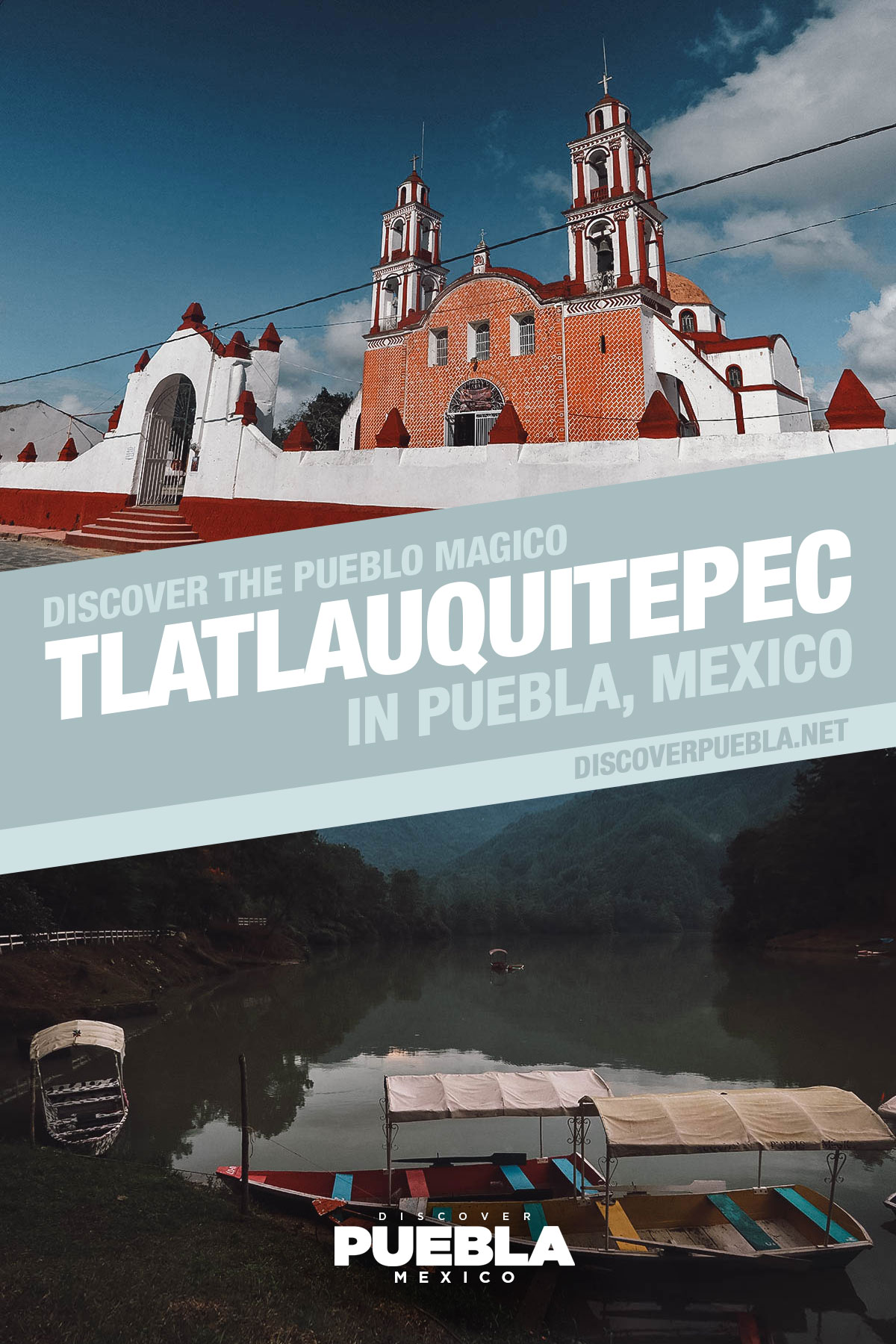
TABLE OF CONTENTS
MEXICO TOURIST CARD (FMM)
I didn’t need a tourist visa to enter Mexico but some people may depending on the type of passport they carry. You can check iVisa.com for more information on Mexico tourist visas.
Whether or not you need a tourist visa to visit, all travelers will still need an FMM (Forma Migratoria Múltiple) to enter Mexico. It’s often referred to as a “tourist card” and it’s something you can get when you travel to Mexico by air or by land.
Tourists traveling to Mexico by air are usually provided one by their airline (cost included in the airline ticket) while people traveling by car can get one at the border (with a fee).
You can also process the FMM ahead of time online through the INM website or iVisa.com. Click on the link to learn more about the FMM.
TLATLAUQUITEPEC AT A GLANCE
Ciudad de Tlatlauquitepec is a town and municipality in the Sierra Norte region of Puebla state, around a 37-mile drive (60 km) south of Cuetzalan del Progreso. It has a population of just over 55,500 and was designated a pueblo magico (magical town) by the Secretariat of Tourism in 2012.
Tlatlauquitepec is affectionately called “Tlatlauqui” by the locals but it’s also known by another name – “Garden of the Sierra”. Home to lush forests, waterfalls, caves, and coffee plantations, the town’s location in the Sierra Norte mountains makes it an ideal base to enjoy the outdoors.
Tlatlauqui’s most emblematic feature is Cerro Cabezón (pictured below), a small but impressive mountain located just outside of town. Capped with lush vegetation, the mountain is known to change color at different times of the day.
A defining feature of this town, the name Tlatlauquitepec stems from the Nahuatl words tlatlahui (to color), téptl (hill), and co (place). Put together, it means “hill that colors”.
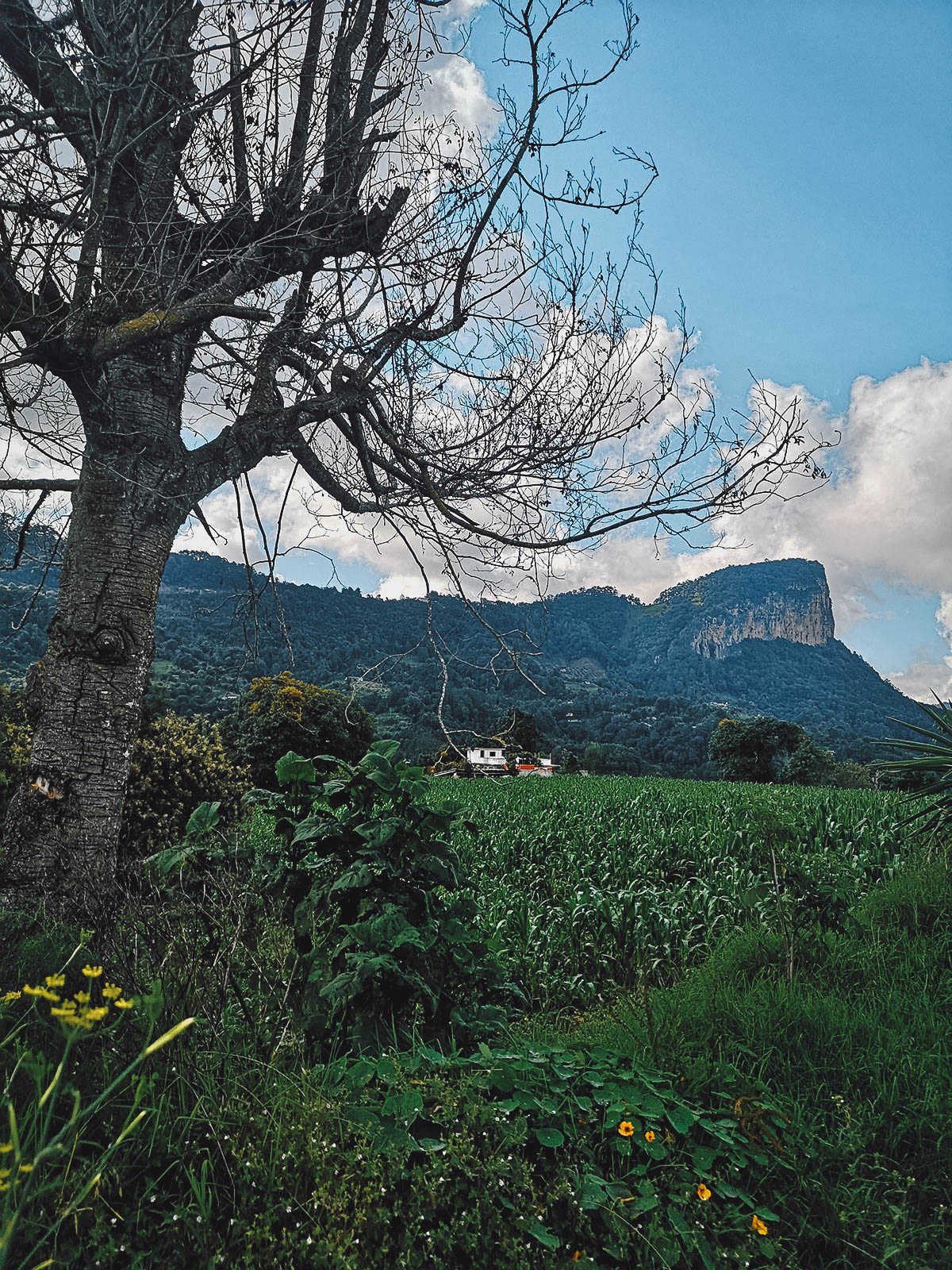
IS TLATLAUQUITEPEC SAFE?
Personally, I felt completely safe in Tlatlauqui. The people here were some of the warmest I met anywhere in Mexico. From restaurant servers to tour guides to random locals I encountered on mountain paths, everyone made me feel at ease and welcome.
Some parts of the country have a reputation for being unsafe but Puebla is considered one of the safest states in the country. It’s a big reason why we decided to make it our base in Mexico.
Having said that, it doesn’t mean bad things can’t happen in Tlatlauquitepec and Puebla. They can happen anywhere but as long as you prioritize safety and follow the usual travel precautions – ie don’t walk alone at night, don’t wear flashy clothing and jewelry, stay in populated areas, etc – then you should have an incident-free time in Tlatlauqi.
The US, Canada, and UK governments give general Mexico travel advisories but I highly recommend bookmarking and keeping an eye on the Puebla and Tlatlauquitepec Tripadvisor forums as well. If there are any recent events you need to know about – incidents that don’t always make the news – then you can probably read about them there first.
BEST TIME TO VISIT TLATLAUQUITEPEC
Tlatlauquitepec experiences a humid climate for most of the year. Its weather is similar to Cuetzalan del Progreso though it’s a bit cooler and less rainy.
I went in September which is the wettest month of the year. It rained frequently while I was there though the rain was mostly light and came in short bursts. It did, however, rain quite hard while I was on a rowboat in the middle of Soledad Dam. It was in the pitch black of night so that gave me a bit of a scare.
If you want to visit Tlatlaqui when precipitation is historically at its lowest, then it’s best to go between December and February. You can refer to the Climate Data website for more on Tlatlauquitepec’s weather.
However, firefly watching is an attraction in Tlatlauqui so people interested in that will want to go sometime between May and August.
HOW TO GET TO TLATLAUQUITEPEC
There are many ways to get to Ciudad de Tlatlauquitepec depending on where you are. This guide assumes you’ll be coming from Puebla City, Mexico City, or from other nearby pueblos magicos in Puebla.
From Puebla City
This was a little confusing. When I first inquired about routes to Tlatlauquitepec, the lady at Puebla CAPU’s (main bus station) main Via desk told me that there aren’t any direct routes. You’ll have to go to Zaragoza, Puebla first then catch a Via minivan to Tlatlauqui.
But when I was waiting at my gate to catch a Via bus to Cuetzalan, the guy at a small ticketing kiosk told me that there are indeed direct buses to Tlatlauquitepec from Puebla. According to him, a one-way ticket costs MXN 246.
I was already set in my plans on going to Cuetzalan first before Tlatlauqui so I couldn’t try this direct route, but you may want to confirm the existence of this direct route with Via.
From Mexico City
According to Rome2Rio, you can catch an ATAH bus from Mexico City’s TAPO station to Zaragoza, Puebla. From there, you can then take a Via van to Tlatlauqui for MXN 10.
From Other Pueblos Magicos
Some of these pueblos magicos in Puebla are located in the same general area so you can go from one to the next without having to go back to Puebla City. Here’s how you can get to Tlatlauiquitepec from nearby magical towns.
FROM CUETZALAN DEL PROGRESO: This is what I did. Tlatlauqui and Cuetzalan are located around 37 miles apart (60 km) so they’re best visited on the same trip. I took a Via bus from Cuetzalan to Zaragoza for MXN 58 then took a Via van to Tlatlauqui for MXN 10.
By Rental Car
Driving from state to state in your own car is a popular way of exploring Mexico, especially if you’re coming from the US. If you’d like to rent a car to visit Tlatlauquitepec, then you can do so through rentalcars.com.
WHERE TO STAY IN TLATLAUQUITEPEC
Tlatlauqui is a small town but you’ll find a handful of hotel and homestay options there. Here are a few of the most highly-rated hotels in Tlatlauquitepec:
If you don’t think these hotels are right for you, then you can do a search on Booking.com, Agoda, or Airbnb for alternate listings. You can also search for hotels in Tlatlaquitepec using the handy map below.
THINGS TO DO IN TLATLAUQUITEPEC
1. Enjoy the Zocalo
The zocalo or main square is an ideal place to start when visiting a new city or town in Mexico. It’s located in the heart of the city and is a great place to just sit, sip OXXO coffee, and while away the time.
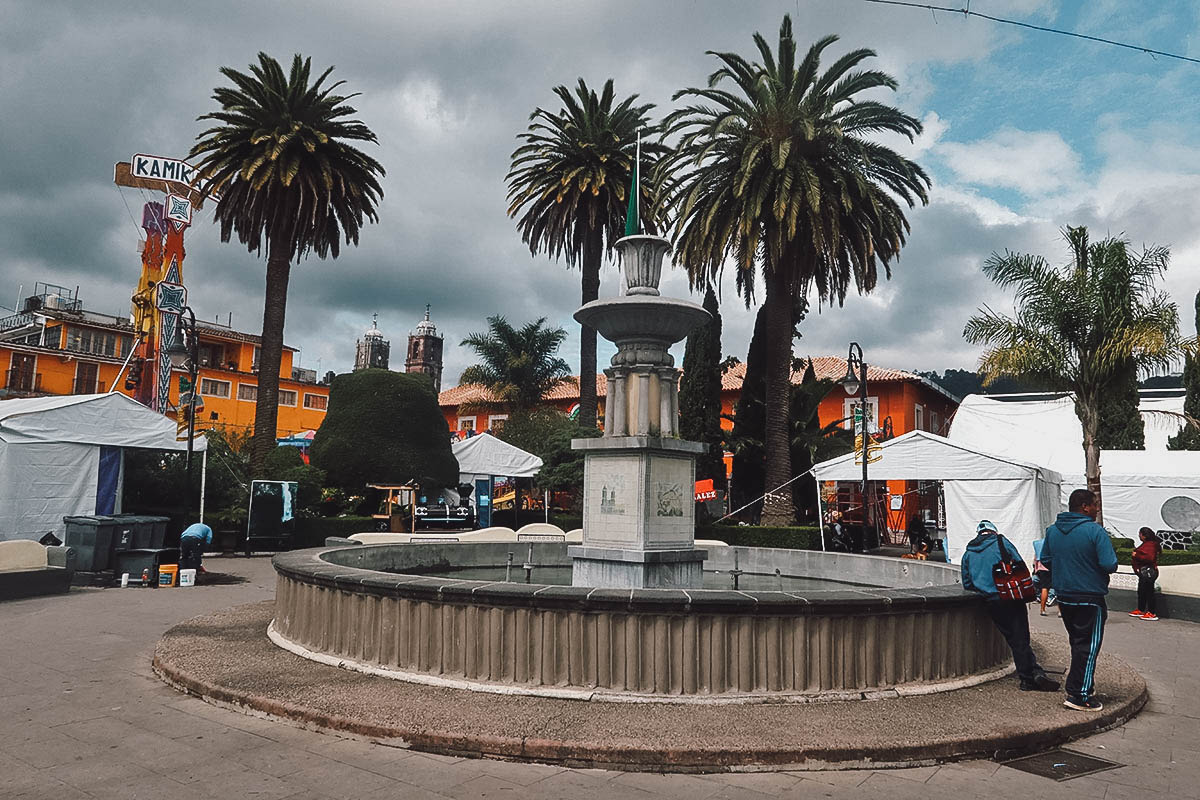
These letras gigantes or giant letters spelling out the town’s name is a common sight throughout Mexico. A popular backdrop for photos, you’ll typically find them at the zocalo.

I was pleasantly surprised to find that my visit coincided with one of the town’s annual festivals – Feria Tlatlauqui. I’m not sure what this particular festival celebrates but it’s a week-long affair featuring shows, live music, parades, activities, a beauty pageant, and more.

For a week, Tlatlauqui’s zocalo was even more festive than usual with colorful carnival rides, games, craft stalls, and food stands set up throughout the square.
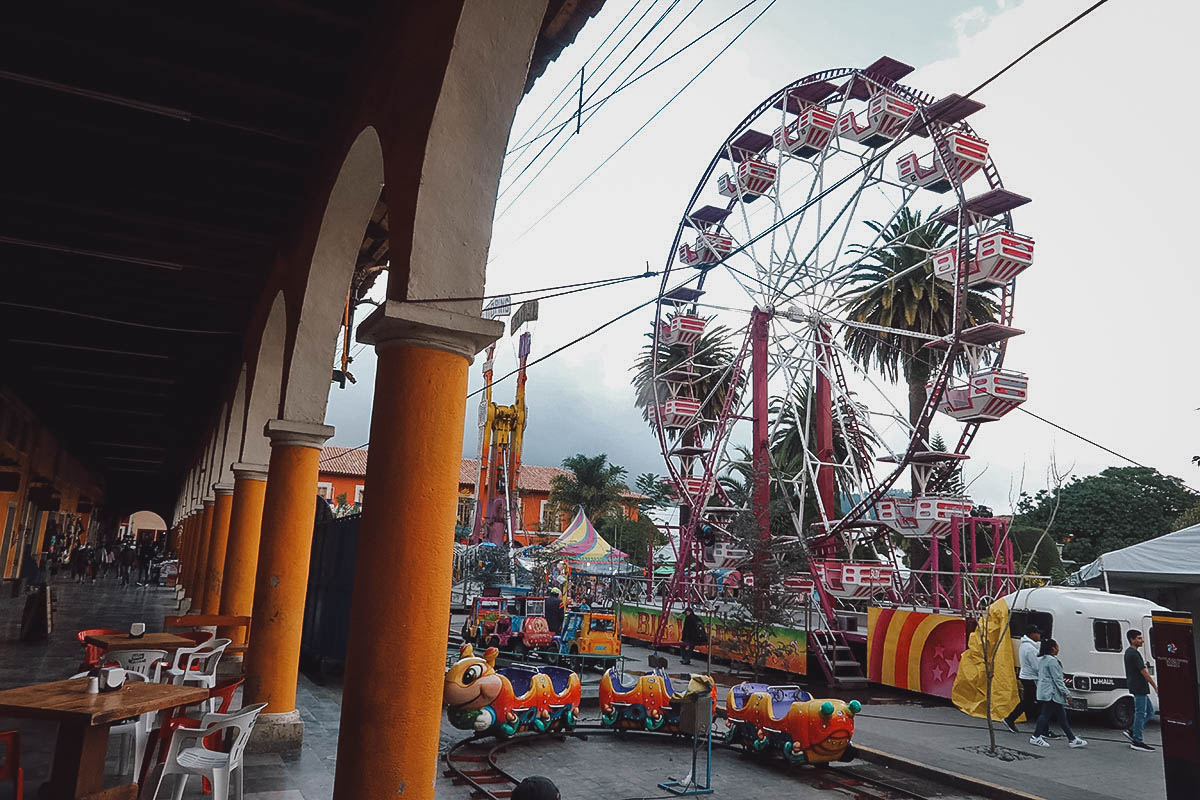
2. Visit Parroquía de Santa María de la Asunción
Parroquia de Santa Maria de la Asuncion is the biggest and most impressive-looking church in Tlatlauqui. Unfortunately, I could never find it open to the public while I was there. I’ve seen pictures and it looks even more beautiful inside.
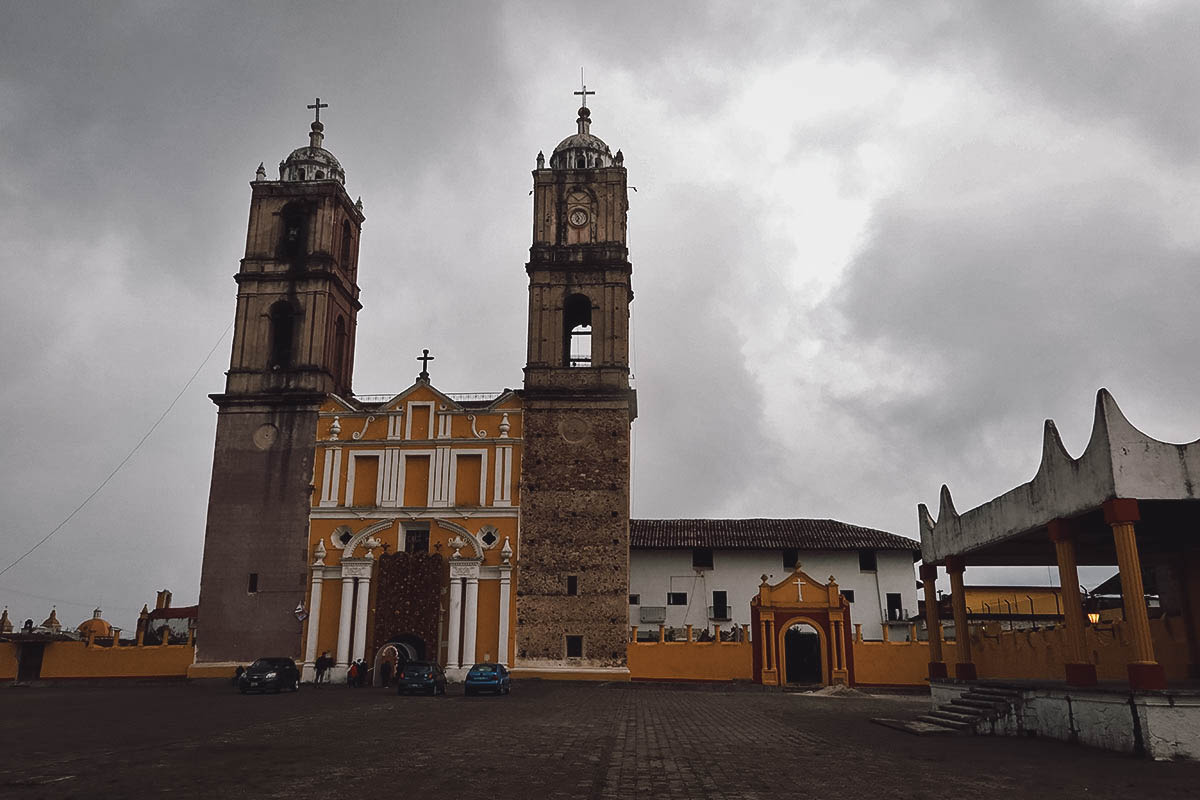
3. Visit Santuario del Señor de Huaxtla
I passed this lovely little church on my way to El Cerro Cabezón. Based on the little information I could find online, Santuario del Señor de Huaxtla is home to a Christ statue that was carved from miraculous wood.
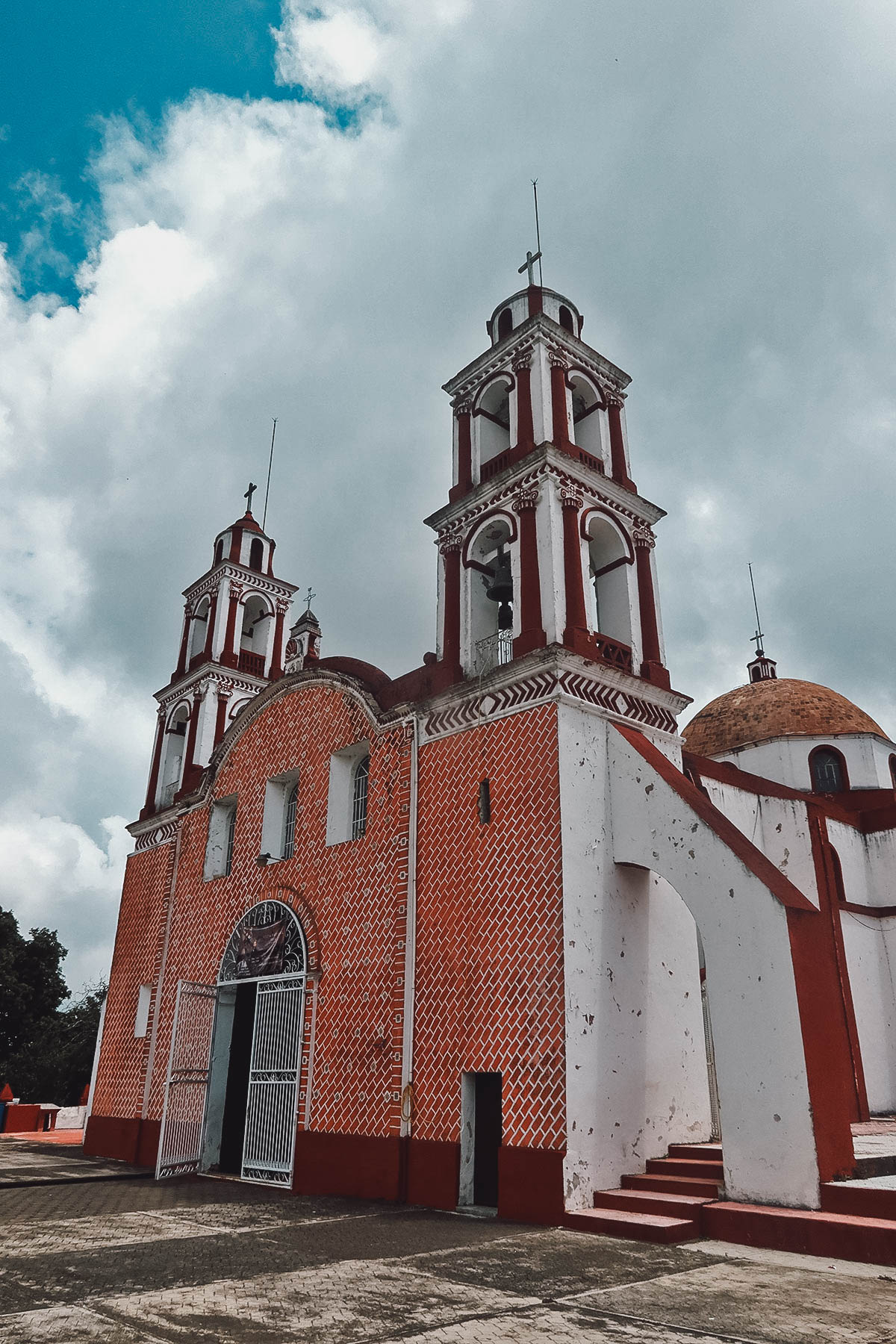
This is what the inside of the church looks like. I believe the venerated Christ statue is what you see in the picture below, in the reredos.
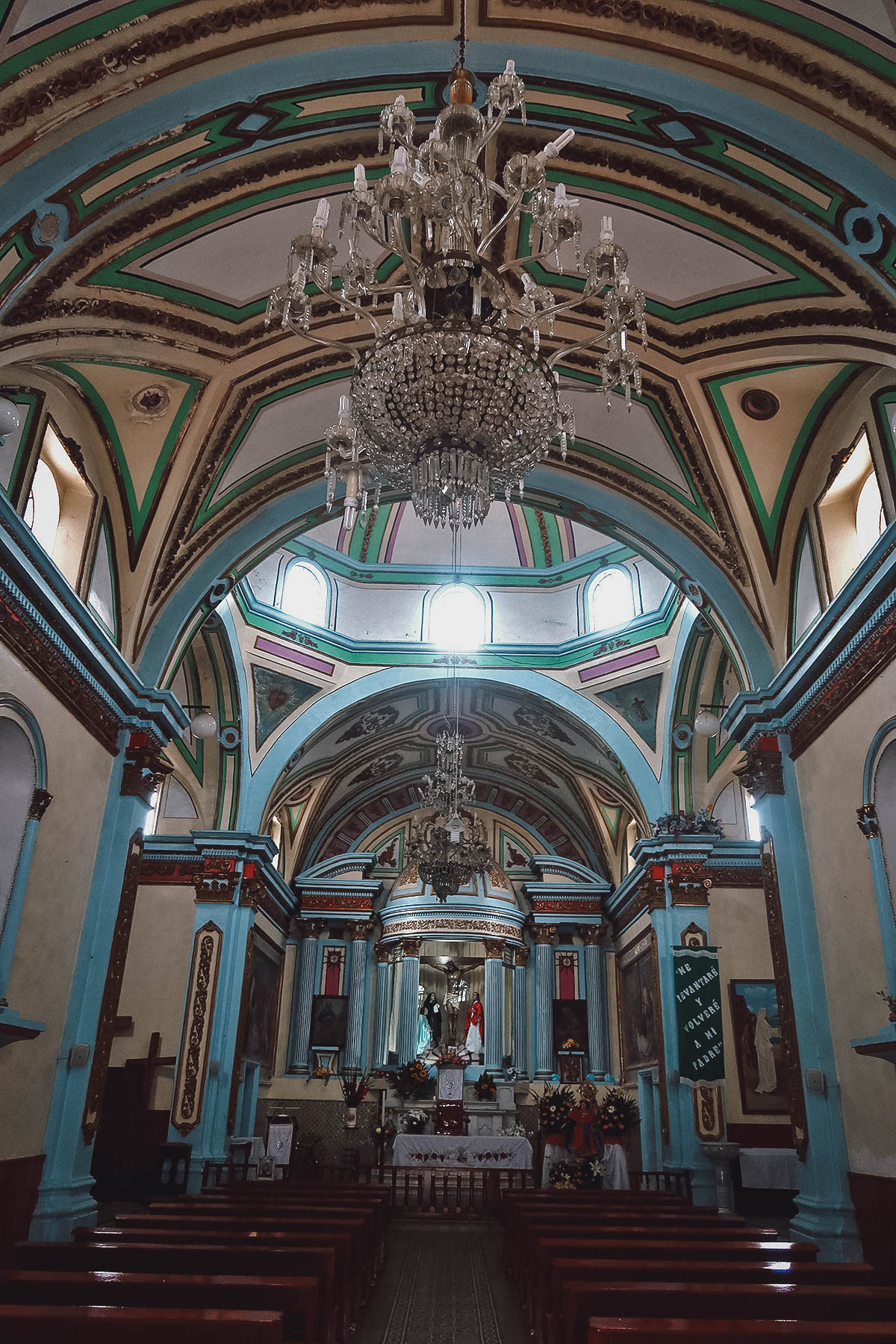
4. Hike to Cerro Cabezon
This was the view of El Cerro Cabezón from my Airbnb in downtown Tlatlauqui. It looks impossibly far from here but it took me around 1.5 hours to get there on foot. It was painful on the quads and the threat of rain was constantly looming over my head but I was rewarded with some of the best views I’ve enjoyed anywhere in Mexico.
Do you see that white speck on the top right of the mountain? That’s the Christ statue pictured further down in this article. Keep scrolling to see what I mean.
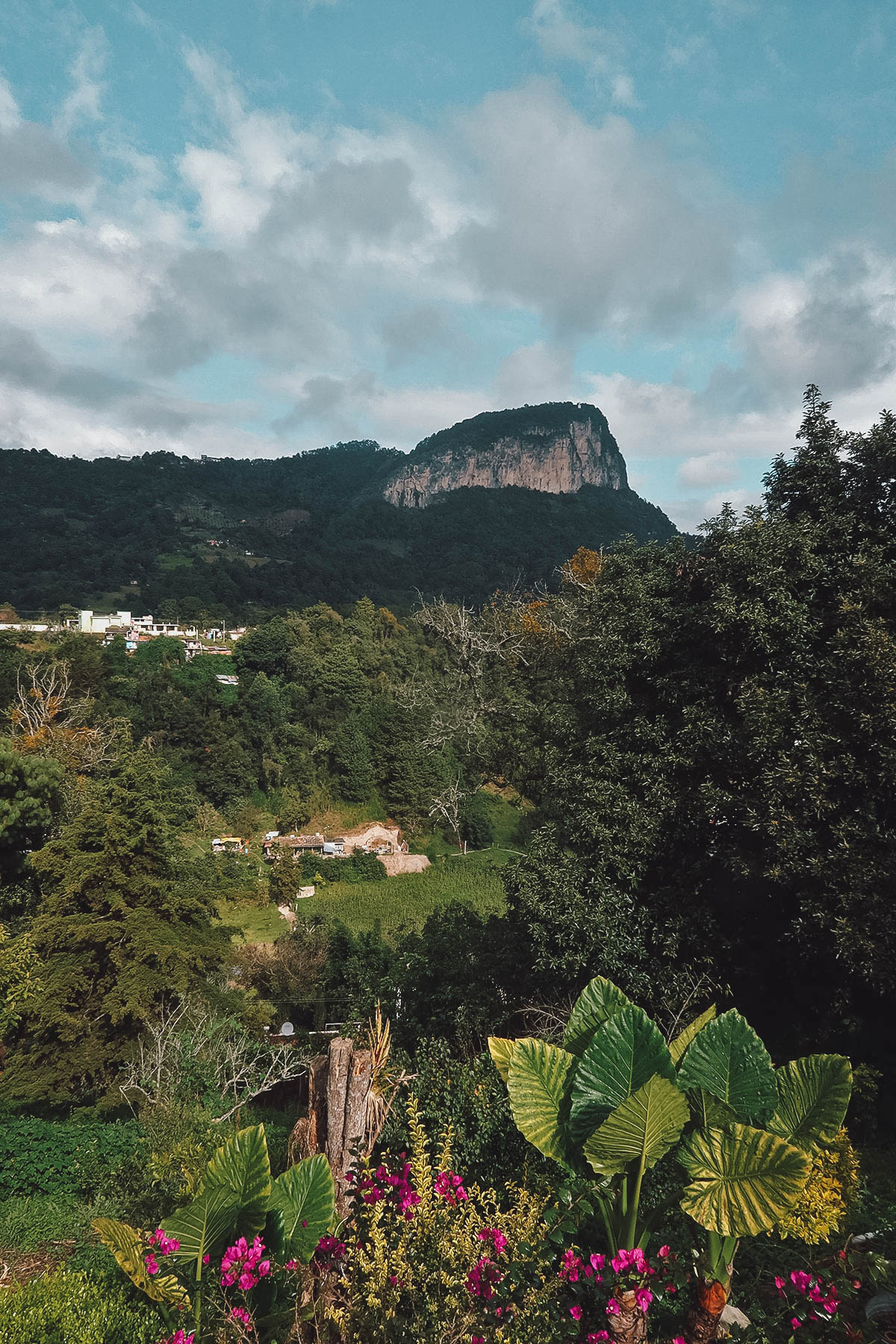
I enjoyed the hike up the mountain but like I said, I was constantly worrying about being caught out in a downpour. Luckily, it never did rain while I was out hiking but you need to be mindful of the weather, especially during rainy season.
I felt safe while hiking but the solitude did have me looking over my shoulder more than once. If you’re concerned about safety or don’t want to walk the entire way, then you may want to book a tour. Ruta con Magia, the company I used for my fireflies tour, offers hiking and horseback riding tours to the mountain.
You can visit the Tourist Information Center at the zocalo as well to inquire about other tour options.
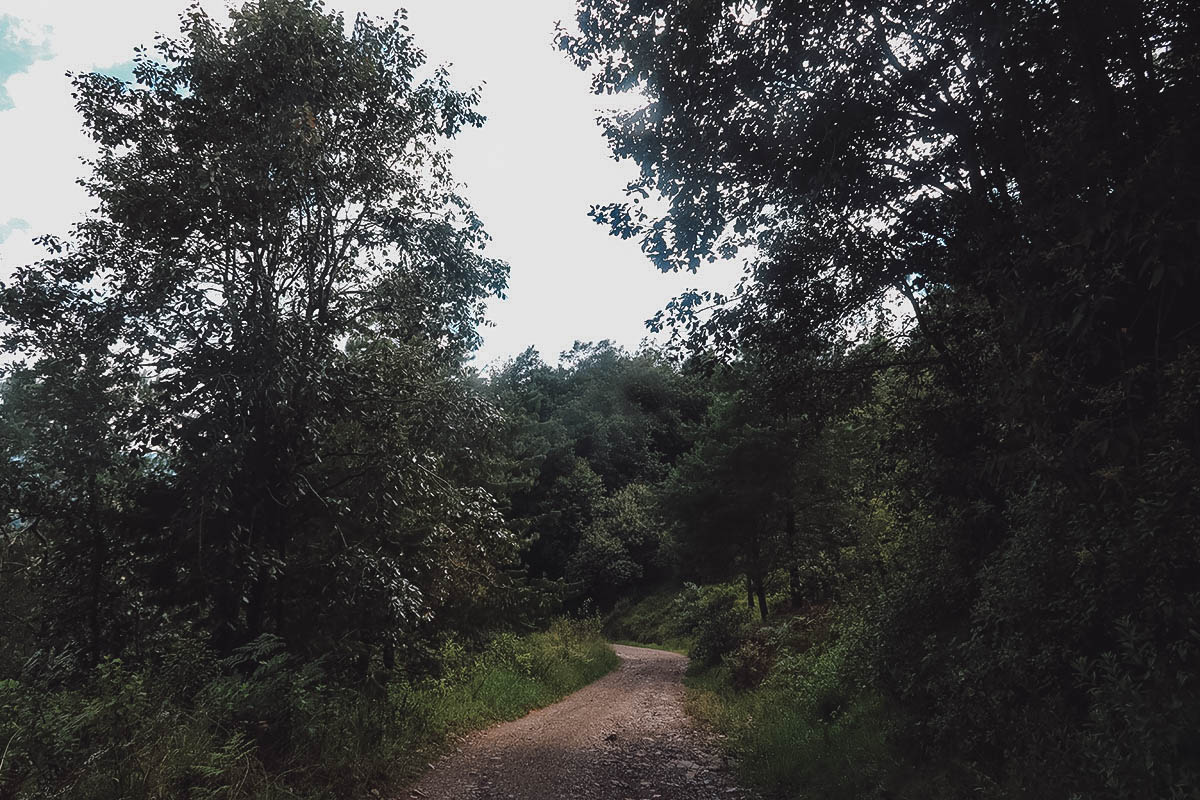
Puente Colgante Tibetano Nuboso
People looking for adventure will have lots to do once they reach the top of the mountain. One of the most popular activities is to cross this bridge – Puente Colgante Tibetano Nuboso (literally “Cloudy Tibetan Hanging Bridge”). Doesn’t it look awesome?

Unfortunately, I was here on a Monday and the hanging bridge is open only on Saturdays and Sundays. Major bummer.
If you visit El Cerro Cabezón over the weekend, then you can enjoy this puente colgante along with other outdoorsy activities like camping, ziplining, and rappelling.
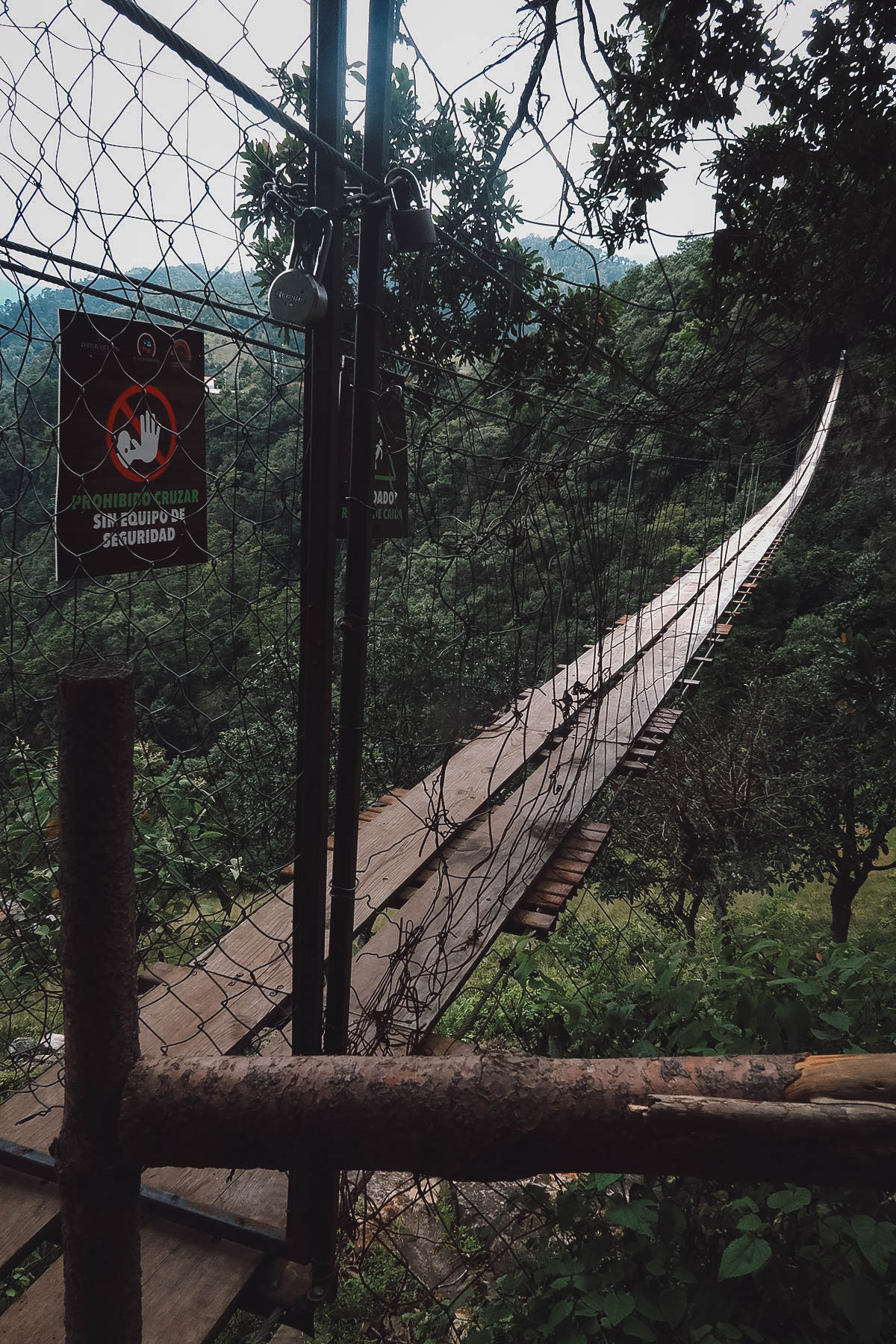
Monumento Cristo Rey
Remember that white speck I mentioned earlier? This is it. That white speck is this Christ statue standing at the apex of El Cerro Cabezón. From here, you can enjoy the most breathtaking views of Tlatlauqui and the surrounding valleys.
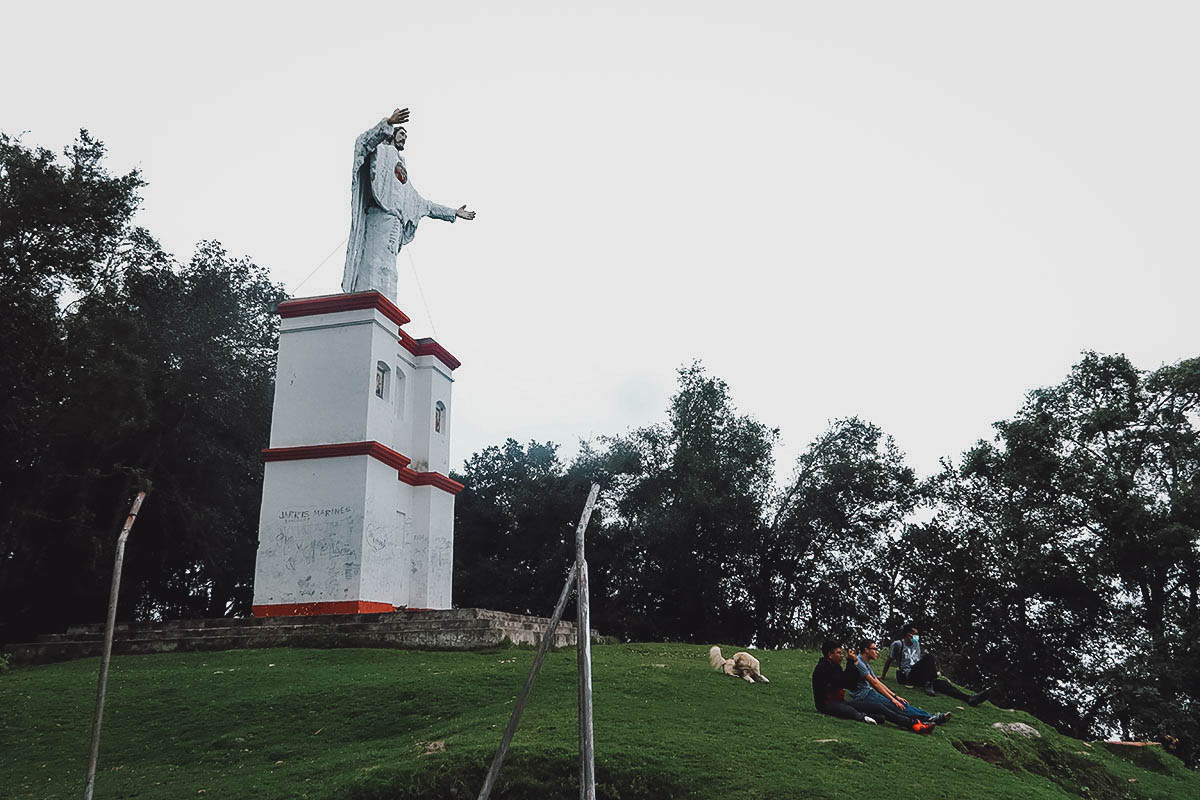
It was foggy for much of the time but once the clouds cleared, I was treated to this incredible view. I was standing on the base of the Christ statue when I took this picture.
Somewhere down there is my Airbnb. It’s amazing how you can hike up here in just 1.5 hours!

5. Go on a Fireflies Tour
I read that firefly watching is a thing in Tlatlauqui. It’s a seasonal activity that’s best done in May or June but you can enjoy it all the way till August or September. I was here in September so I wasn’t sure if I could still catch them, but luckily, a tour company was able to take me.
I went to the Tourist Information Center and asked about firefly tours and they offered two options – Explora Tlatlauqui and Ruta con Magia. I contacted both companies and went with the latter. They took me on this fireflies tour to Soledad Dam for MXN 950. If I remember correctly, pick up time was at 6PM and the tour lasted 4-5 hours.
The dam is about an hour’s drive north of downtown Tlatlauqui so we made several sightseeing stops along the way, starting with Cascada de Puxtla Tepantzol which you can see from across the valley. I believe they offer tours that take you closer to this waterfall.
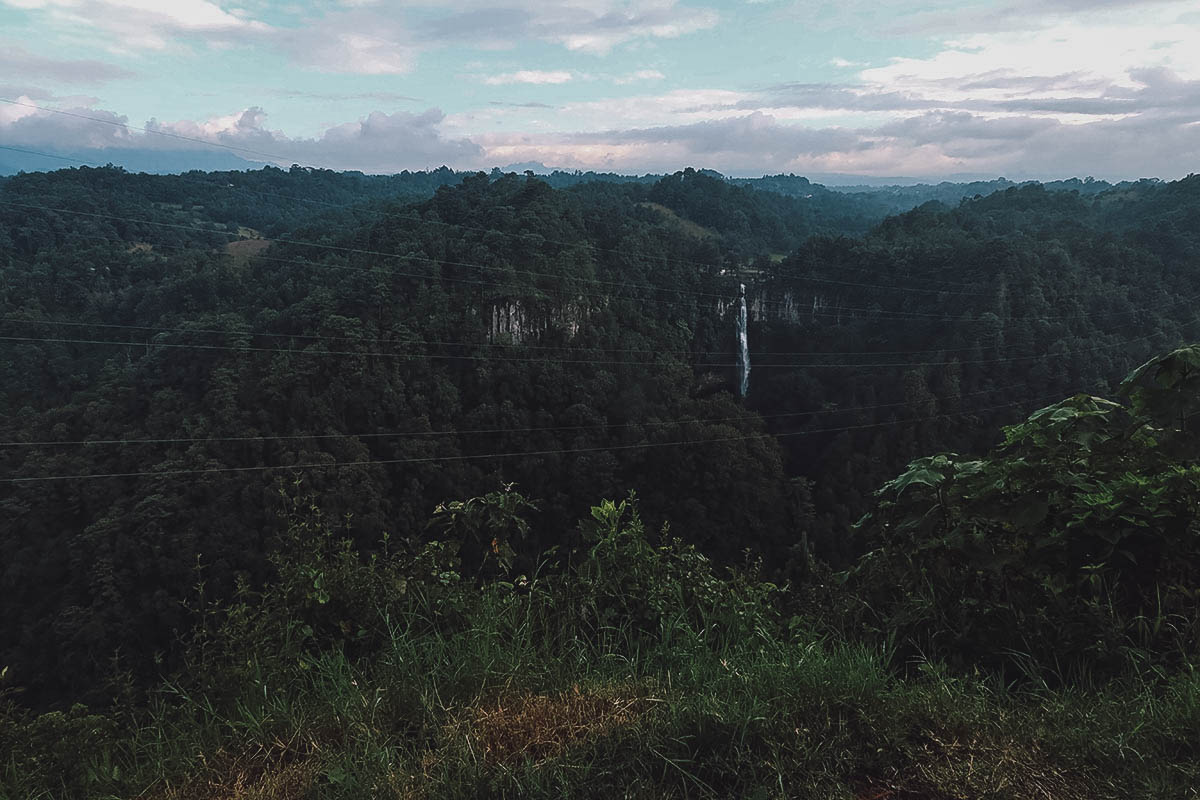
Tlatlauqui is known for its coffee so my tour guide stopped at a plantation so I could look at the coffee cherries. Aren’t they cool? We drink coffee everyday but rarely do we see where they actually come from.
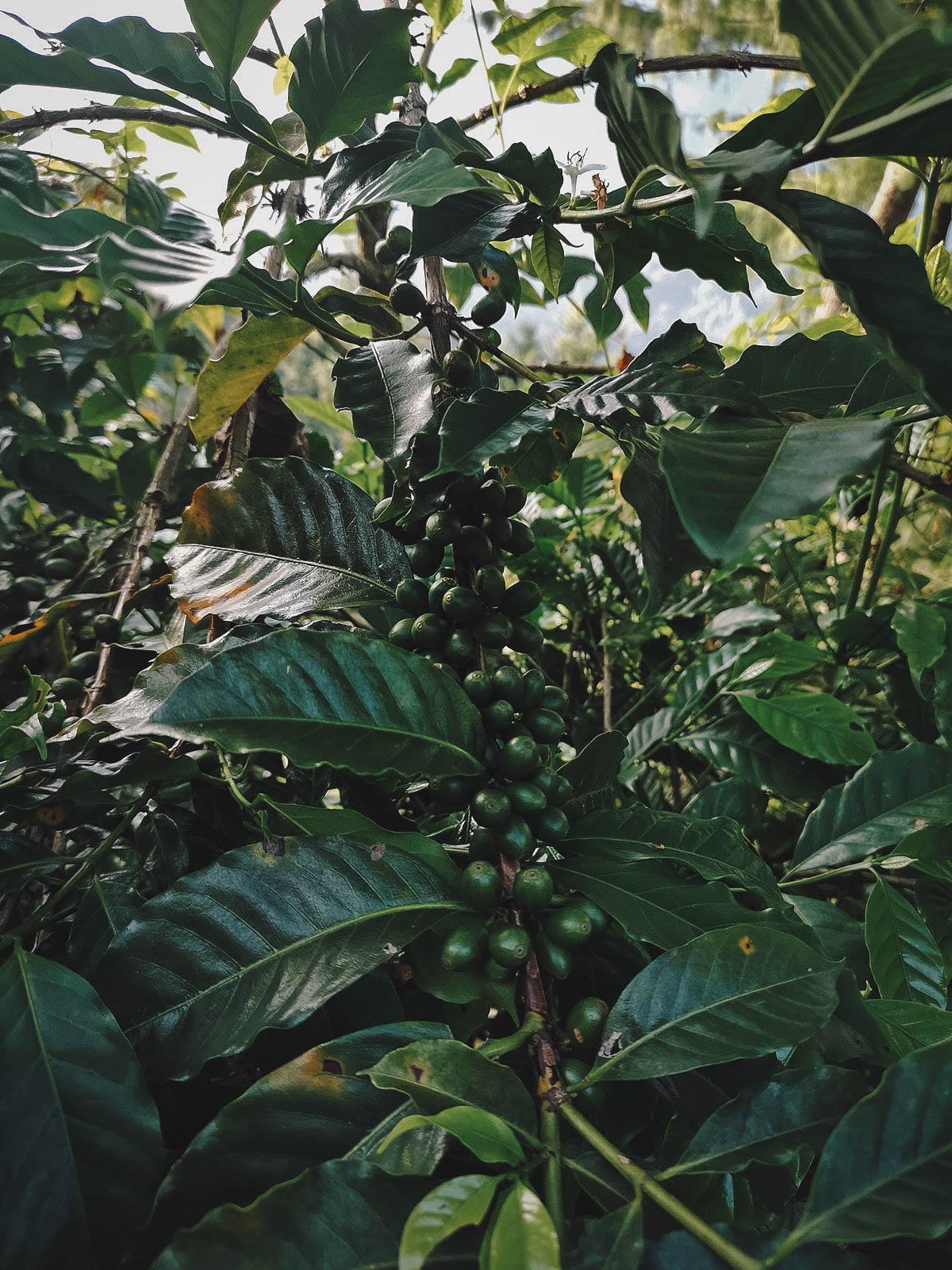
This was the view from the coffee plantation. Breathtaking isn’t it? It isn’t hard to see why Tlatlauqui is known as the “Garden of the Sierra”.
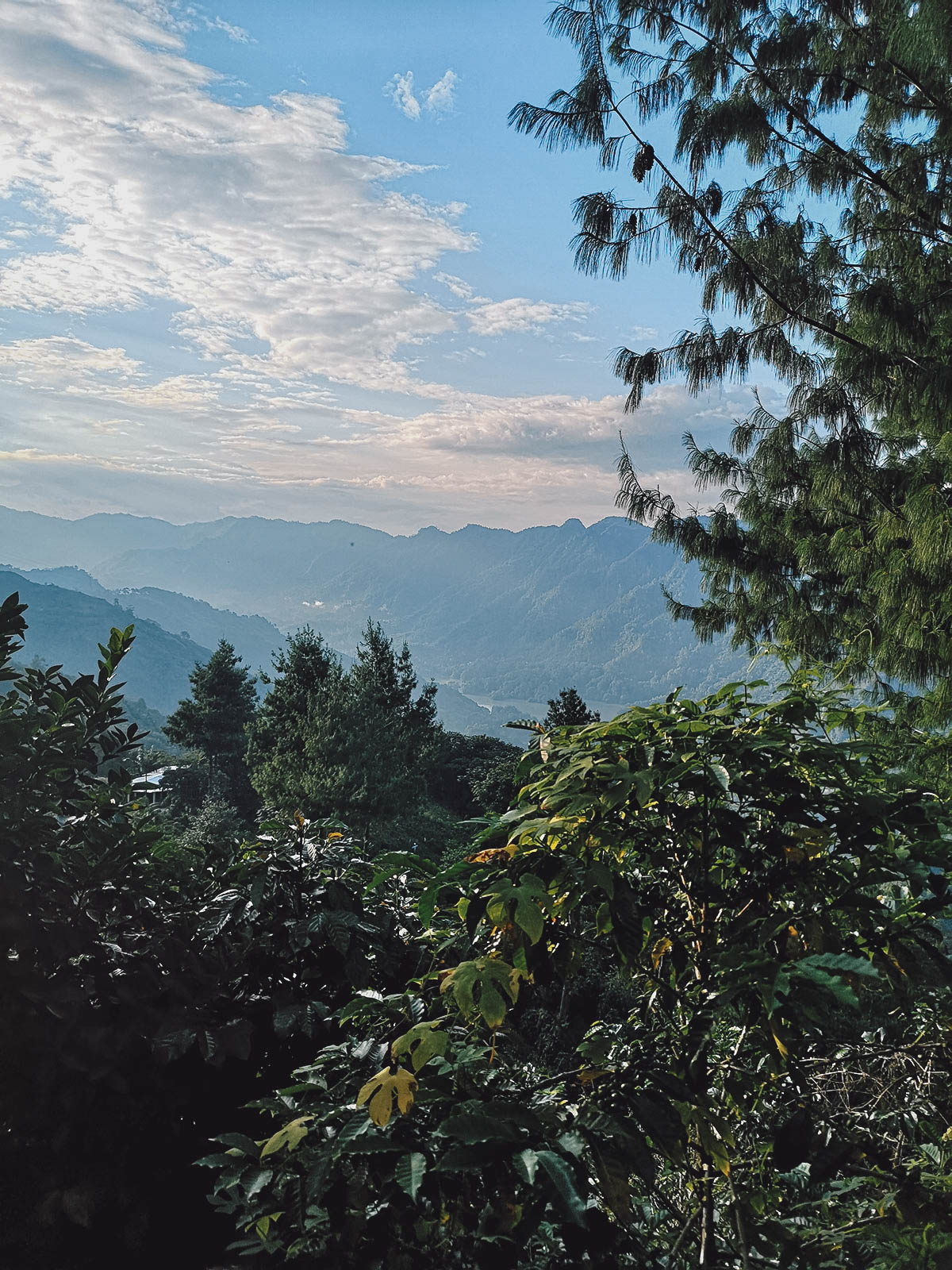
Another picturesque waterfall to take up space on your memory card. You can get up close to this one.

Presa la Soledad or Soledad Dam is where you’ll go to observe the fireflies. You’ll get on a rowboat and be taken to the middle of the dam after sunset.
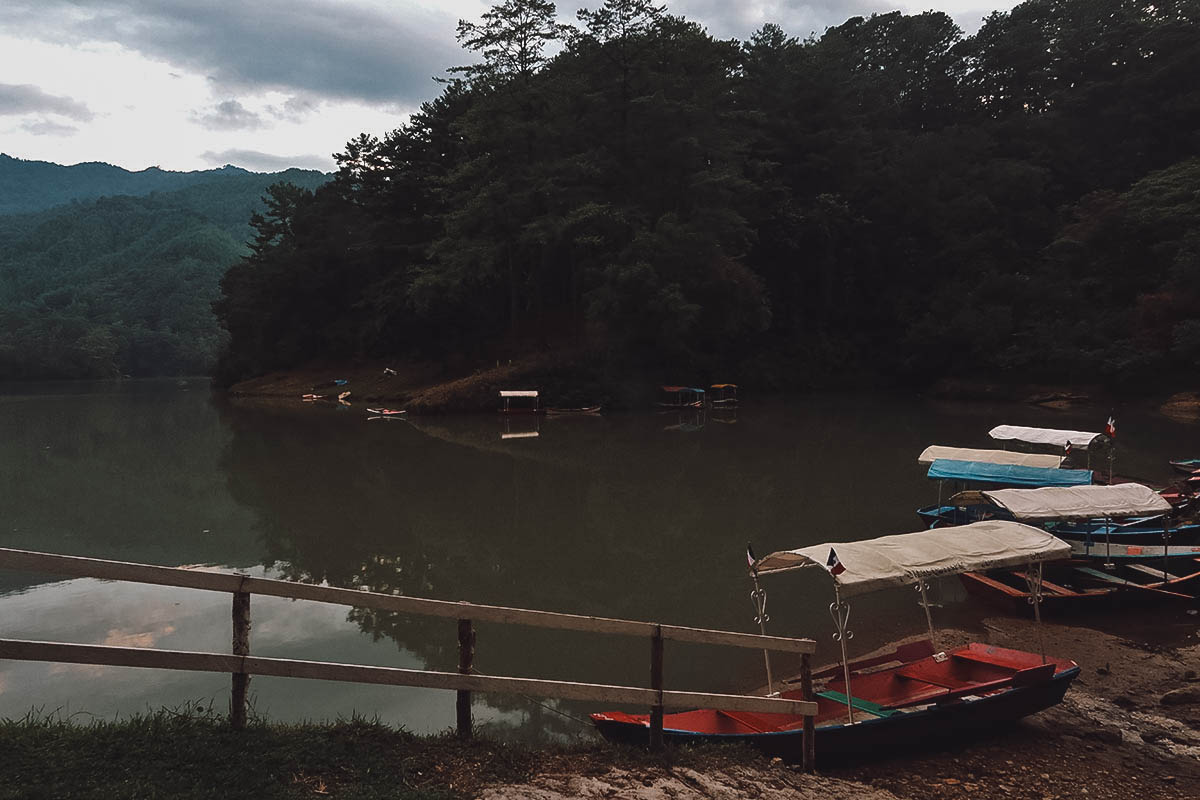
It takes some time to get to the area of the dam where you can observe the fireflies. By the time you get there, the sun has completely set and it’s pitch black out on the water. There are virtually no houses around so it’ll be just you, your boatman, and the sound of his oars cutting through the water.
And the fireflies. Thousands of them.
I tried to take photos and videos but it was too dark to catch anything meaningful. There were a decent number of fireflies in the trees but according to my boatman, there are many more in May or June. To be honest, I was a bit underwhelmed by the experience so I suggest saving this experience for May or June instead.
We were getting ready to row back to the dock when the first droplets of rain started to come down. Uh oh.
Luckily for me, I had a jacket and a small umbrella but it was hardly enough to shield me from the heavy downpour. The rain was so strong and so loud that I couldn’t hear the oars splashing through the water. It felt like a silent movie.
By the time we got back to shore, my bottom and arms were completely soaked. But I didn’t mind because I was alive and had new stories to tell. I gave my elderly boatman a good tip before driving back to Tlatlauqui with my tour guide.

6. Go on More Outdoor Adventures
I only had time for Cerro Cabezón and Presa la Soledad but if you plan on staying longer in Tlatlauqui, then perhaps you’d be interested in doing more outdoor activities.
Looking at the map I got from the Tourist Information Center, there are more natural attractions in the region like caves, waterfalls, mountains, and lagoons, most of which are too far to visit without a car.
Ruta con Magia offers several outdoor adventure tours but I suggest visiting the Tourist Information Center as well for more options.
POBLANO FOOD GUIDE
The state of Puebla is home to some of the tastiest and most interesting Mexican food in the country. Mole poblano and chiles en nogada are the most well-known but there are many other regional dishes that you need to try in Puebla.
Be sure to check out our Poblano food guide for suggestions on what dishes to look for in Tlatlauquitepec and Puebla.
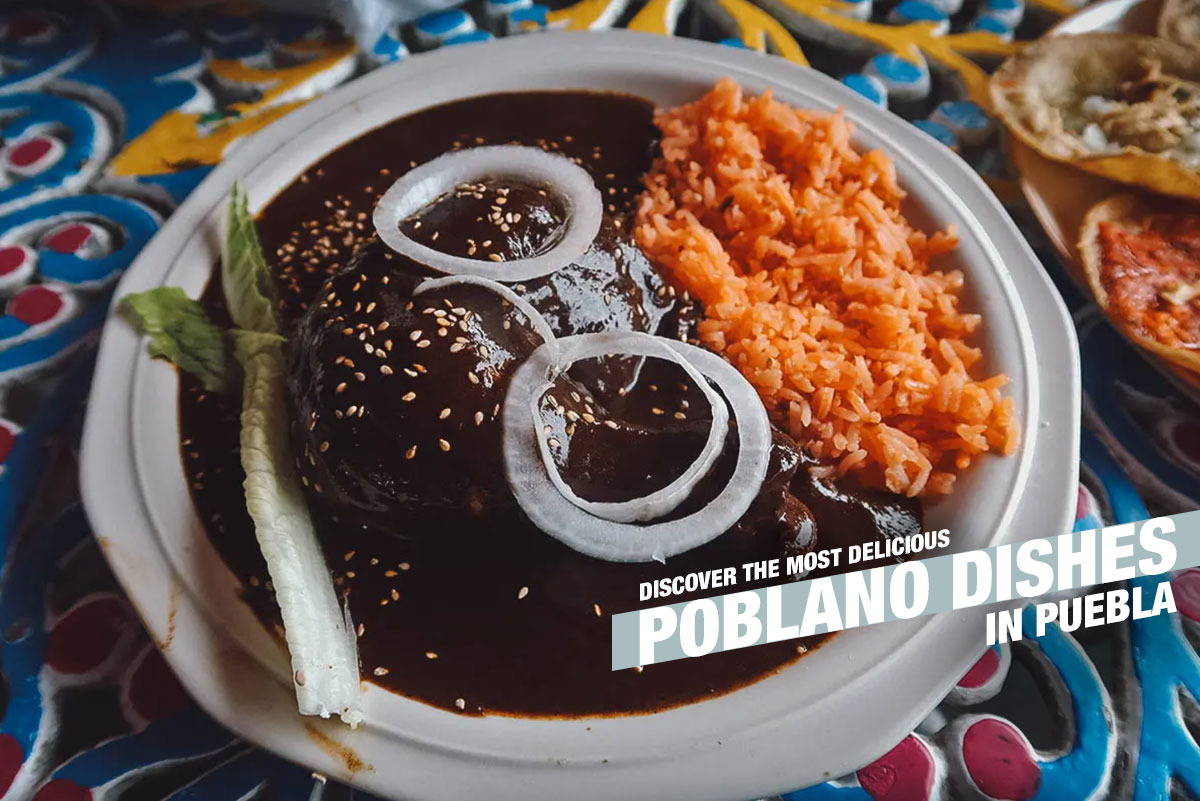
WHERE TO EAT IN TLATLAUQUITEPEC
1. El Buen Cafe
I arrived bright and early in Tlatlauqui so I needed to find a good place to have breakfast before checking in to my Airbnb. I walked by this cute cafe with a chalkboard sign outside that read: “September special, all breakfast for MXN 55”. I found my breakfast place.
All breakfast dishes come with coffee or tea and a bowl of fruit with honey and granola.
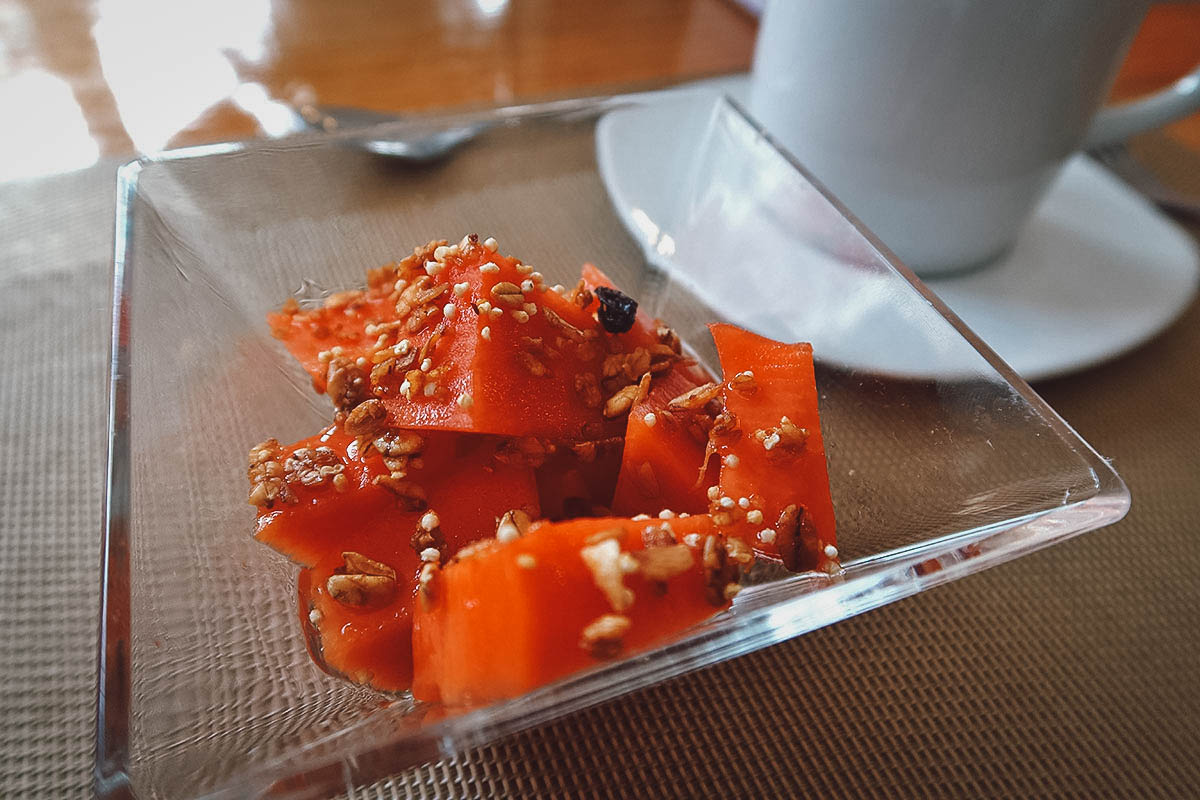
El Buen Cafe offers traditional Mexican breakfast dishes on their menu like molletes, enchiladas, and chilaquiles. I went with the huevos a la cazuela which are basically scrambled eggs served in a clay pot with tomato sauce and cheese. ¡Muy delicioso!
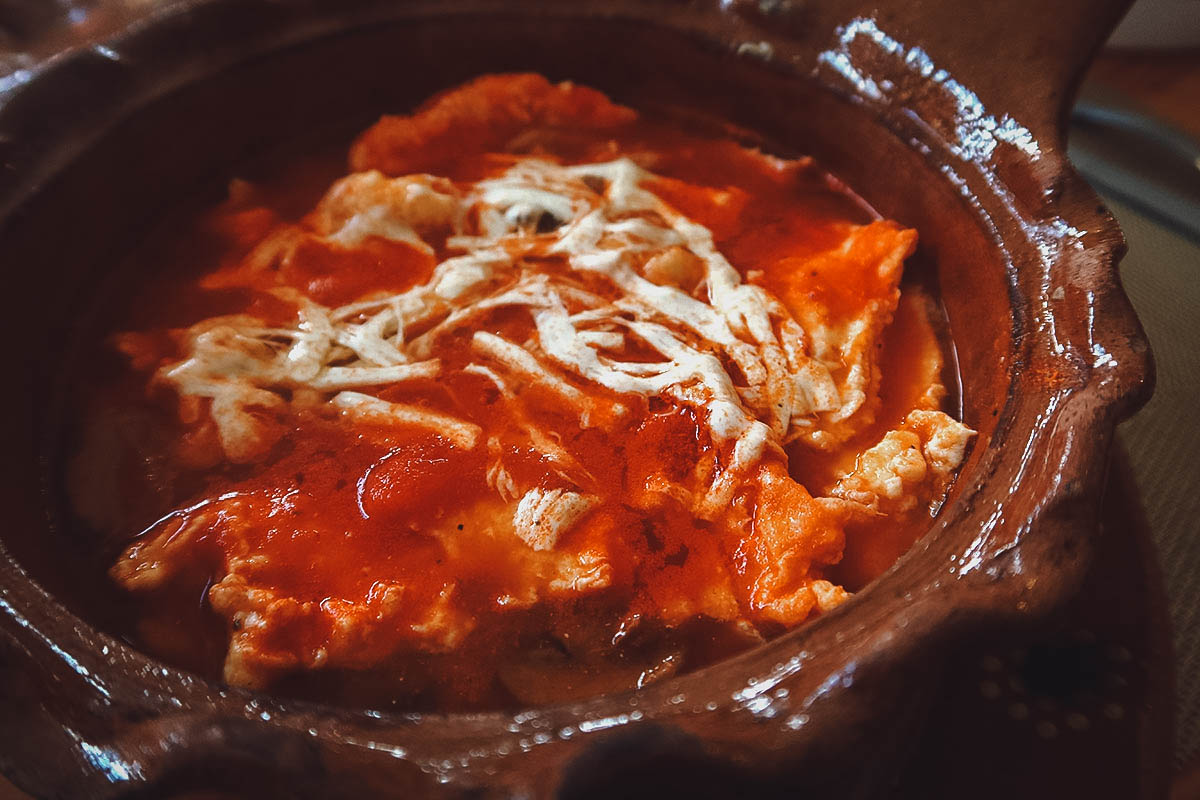
El Buen Cafe is located on Gral. Juan Alvarez, just around the corner from Parroquía de Santa María de la Asunción.
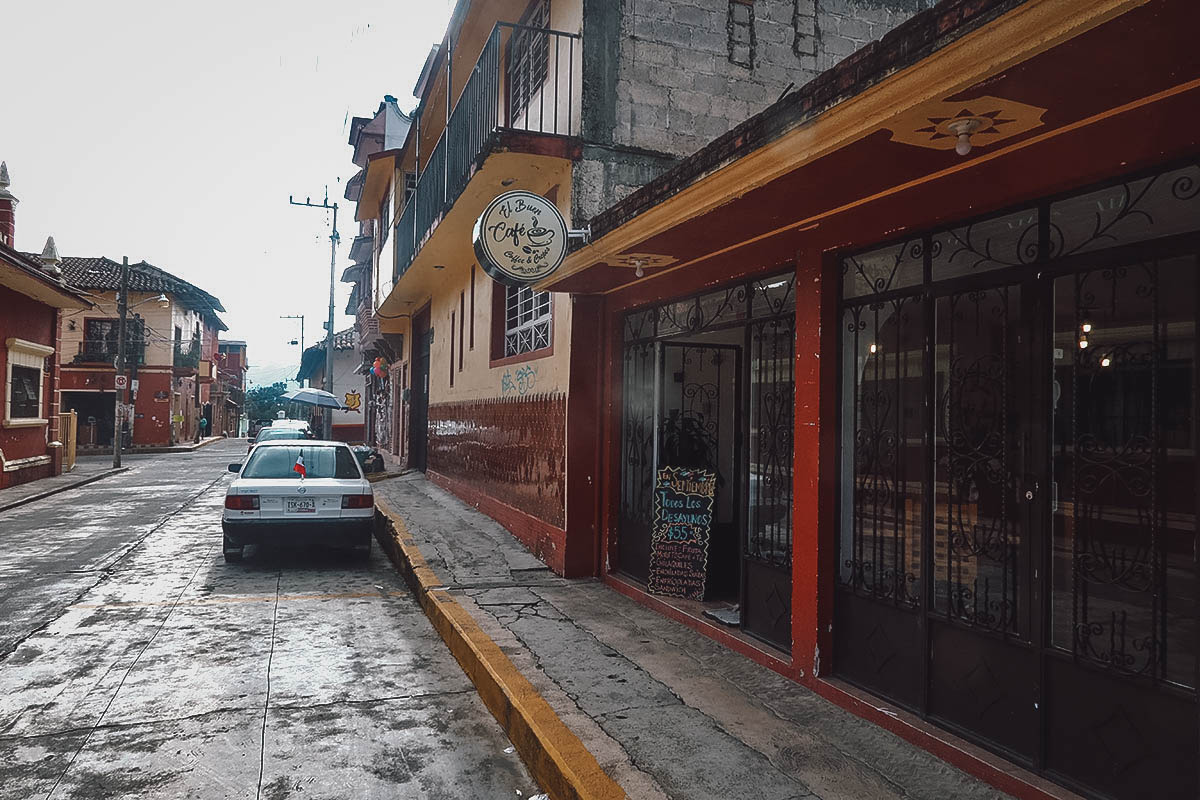
2. Tlayoyos Doña Tere
Tlayoyos Doña Tere was my favorite restaurant in Tlatlauqui. As its name suggests, it’s a traditional restaurant that specializes in tlayoyos but they do offer quesadillas, guisadas, and other antojitos as well.
Doña Tere and her staff are incredibly warm and friendly. In spite of having an almost full restaurant, she took the time to chat with me. She asked me where I was from, where I had been in Tlatlauqui, what I thought of their little town, etc. It made an already enjoyable meal even more special. ¡Muy amable Doña Tere!

Part of the reason why the food here is so good is because they make everything from scratch. Pictured below are fresh tlayoyos and tortillas being toasted on a comal.
A tlayoyo is an oval-shaped Mesoamerican dish consisting of fried or toasted masa stuffed with different ingredients. It’s very similar to a tlacoyo except the dough is prepared a little differently.
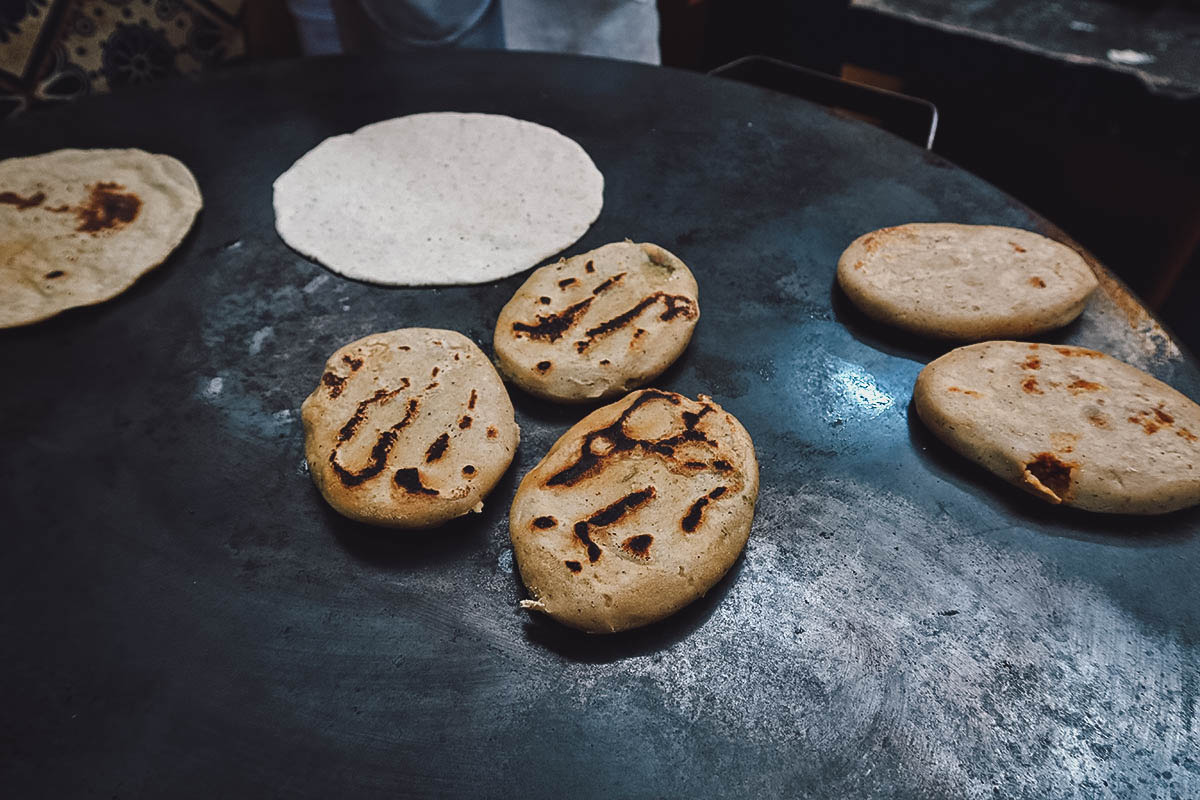
Doña Tere makes tlayoyos filled with different ingredients like alberjones (whole yellow peas), beans, potatoes, and chicharron. They’re topped with crumbled cheese and either salsa roja or salsa verde.
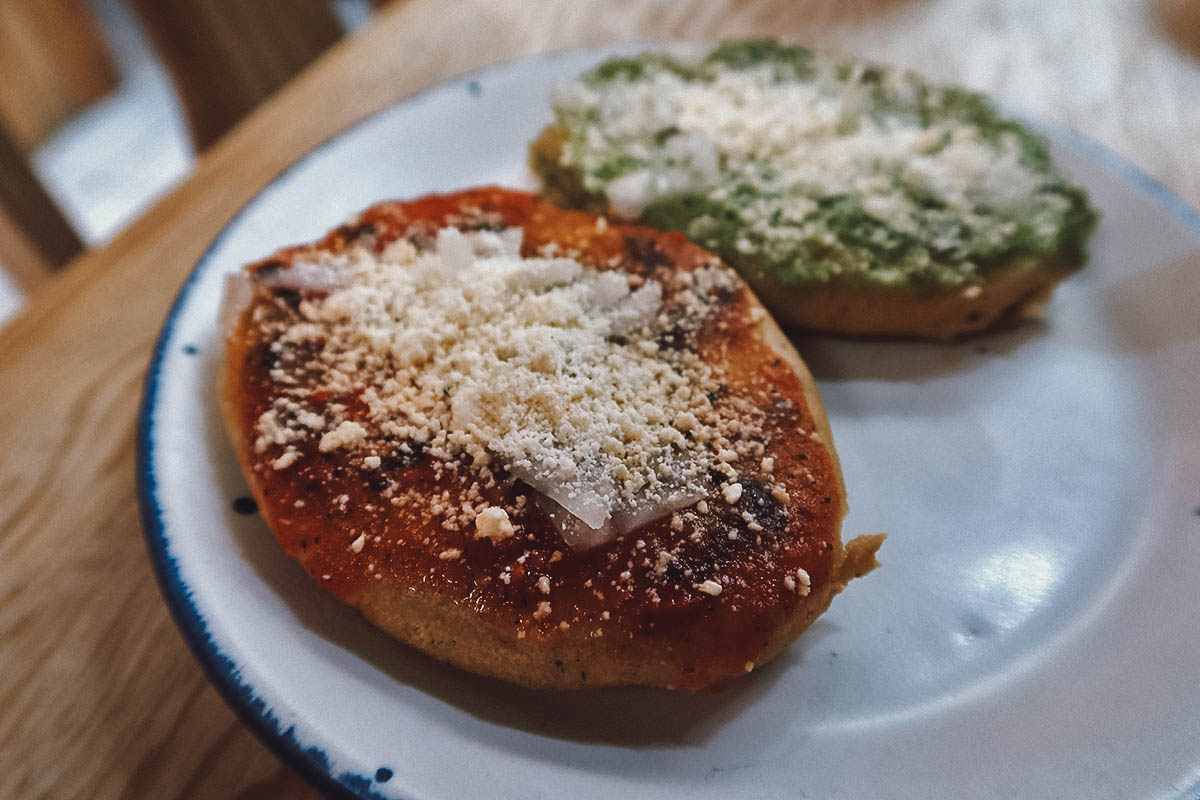
For my main course, I went with one of my favorite Mexican dishes – menudo. Also known as mole de panza or pancita, it refers to a delicious Mexican soup made with cow’s tripe cooked in a red chili-pepper-based broth.
Doña Tere’s version is called pancita de res con pata. She makes it with the addition of cow’s feet. ¡Dios mio this was good!
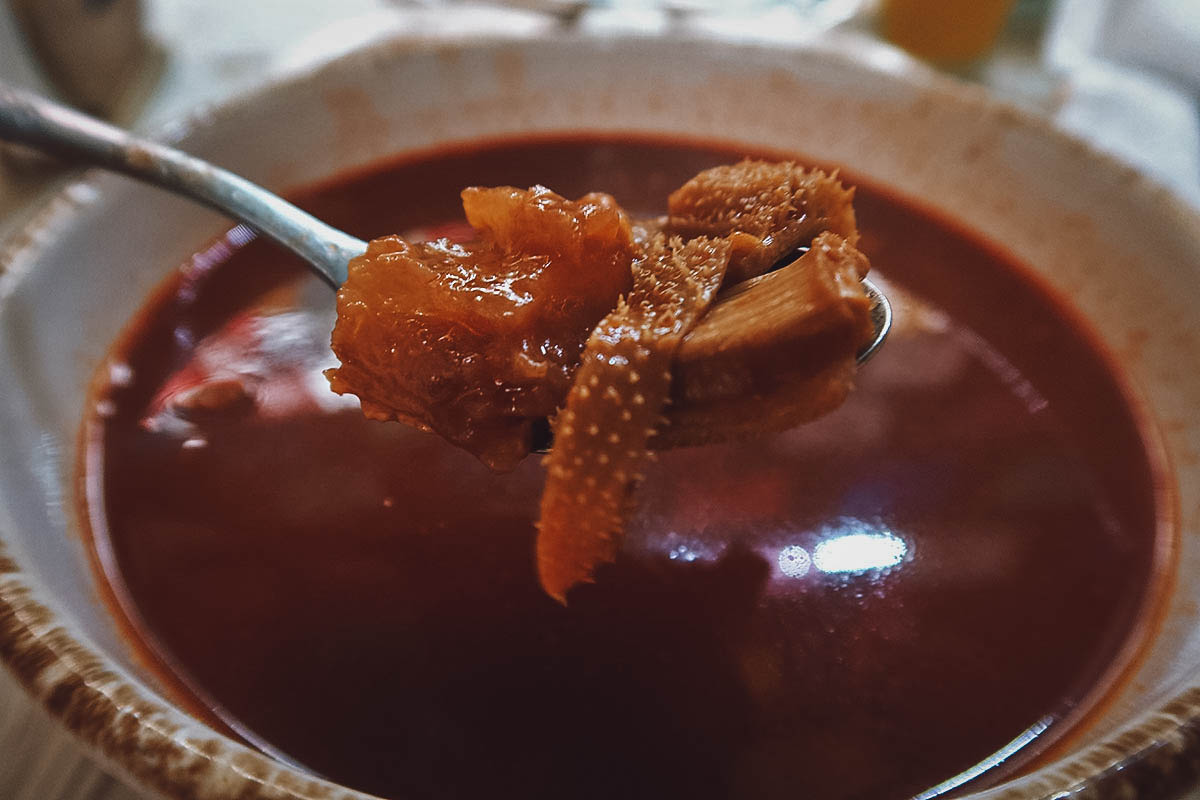
Tlatlauqui may be small but you could easily miss Tlayoyos Doña Tere if you weren’t looking for it. Hidden from plain sight, it’s located inside this building called Plaza Parque just off the zocalo.
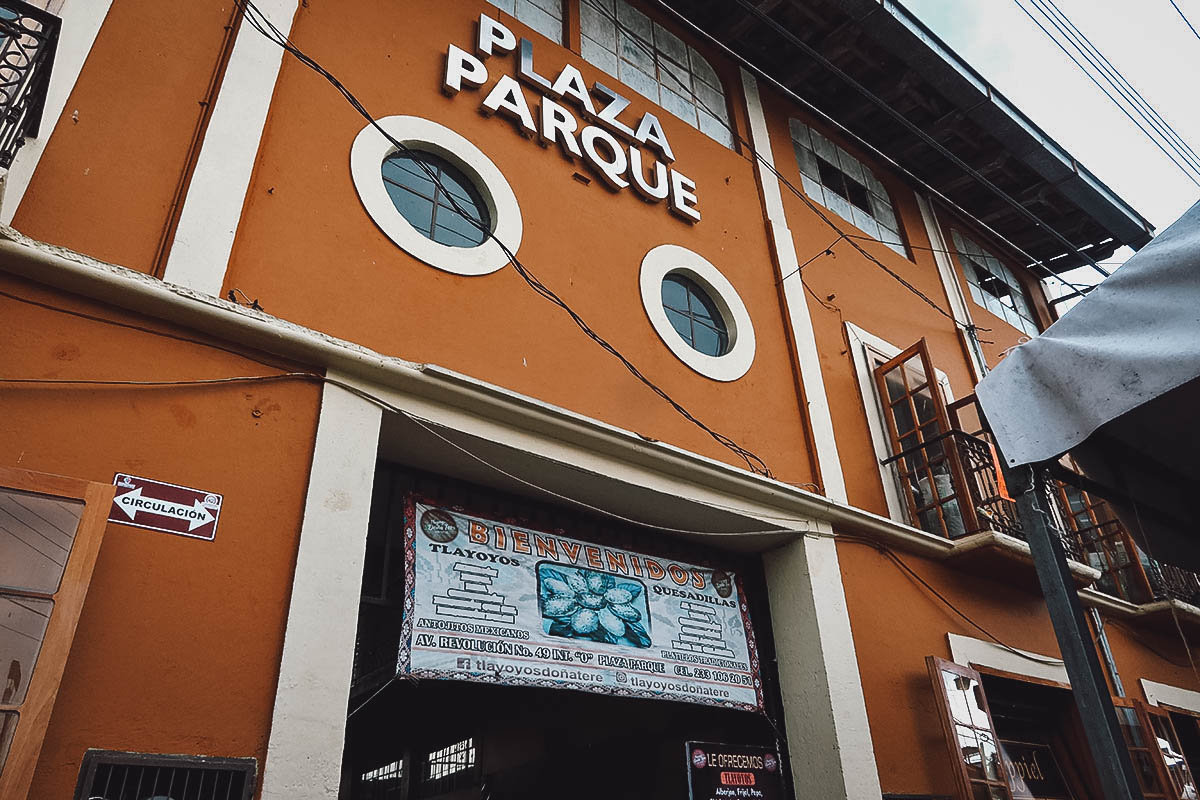
Tlayoyos Doña Tere is one of three or four restaurants inside Plaza Parque. Reminiscent of a homecooked meal, don’t miss it if you’re looking for a truly delicious Mexican meal in Tlatlauqui.
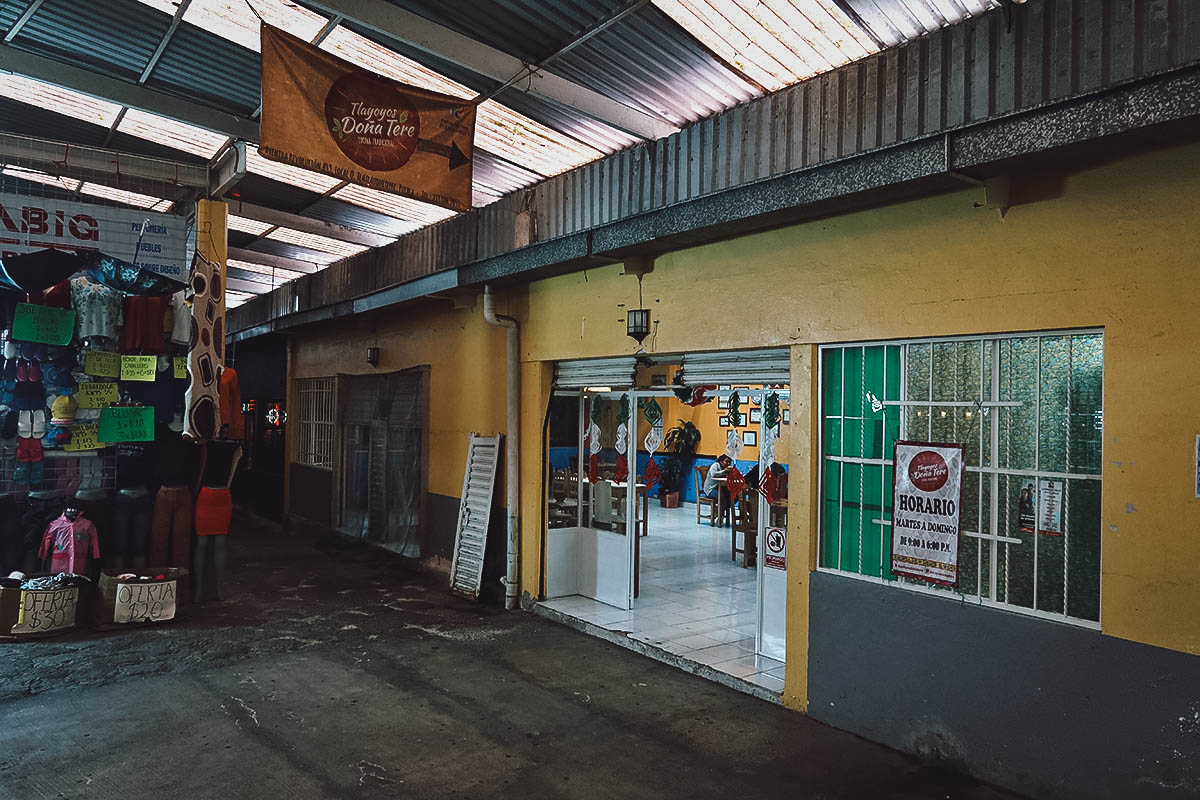
3. El Zarzo
El Zarzo is another popular restaurant near the zocalo. It’s a restaurant and bar that offers a wide menu of spirits and traditional Mexican dishes ranging from desayunos like chilaquiles to platos fuertes like arrachera and cecina.
There were many delicious dishes on their menu but I went with this platter of stewed pulpo or octopus. Being nowhere near the ocean, common sense tells you not to order seafood but I couldn’t help myself! I love all things cephalopod and the pulpo at El Zarzo can be prepared in a number of ways.
I asked my kind server for suggestions and she recommended I get the enchipotlado (cooked with chipotle chilis). She was right, and I wasn’t wrong. It was delicious.

El Zarzo is a dark and moody restaurant bar located just around the corner from the zocalo. If you’re looking to wash down your meal with a few Mexican cocktails and spirits, then this is a great place to visit in Tlatlauqui.

4. Mil Sabores
Like El Buen Cafe, Mil Sabores is a bright and cheery cafe that serves traditional Mexican breakfast fare. As I often do in Mexico, I started my day with a pot of cafe de olla and a few pieces of pan dulce.
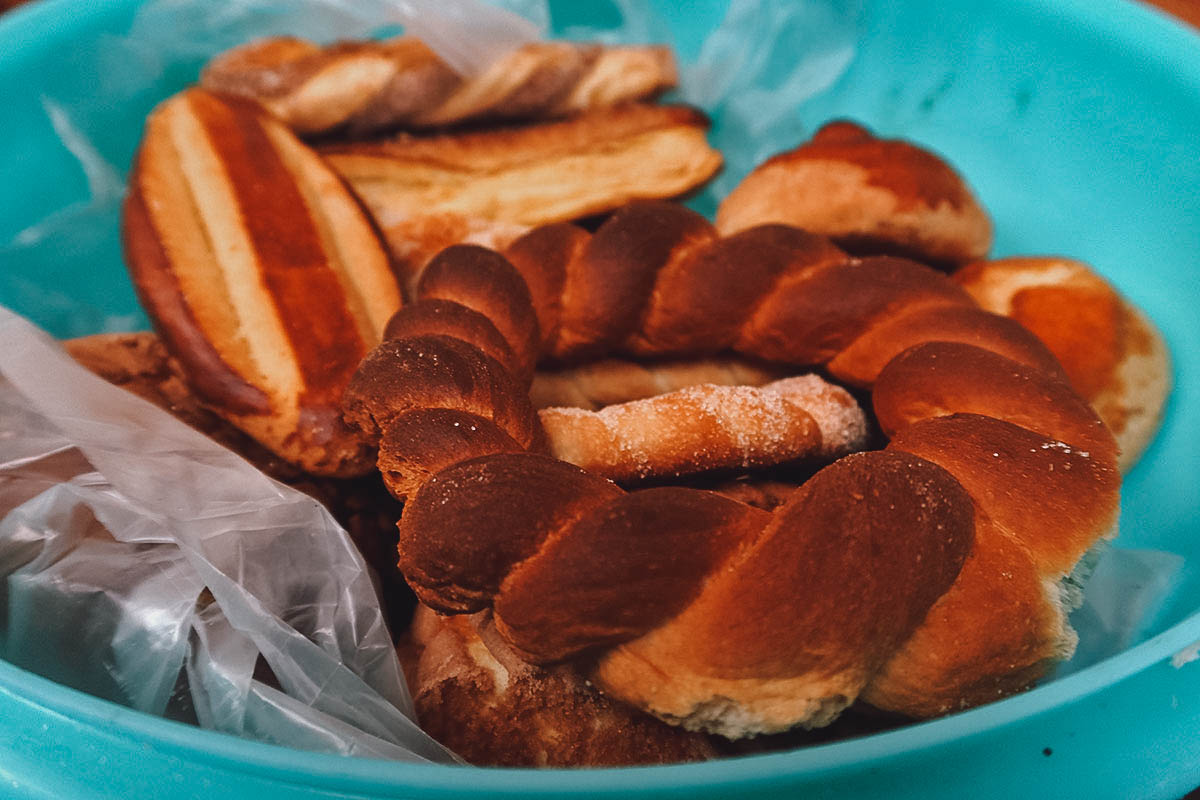
There were many delicious breakfast dishes on their menu like huevos motuleños, molletes, and chilaquiles, but if I see a dish with the restaurant’s name attached to it, then chances are, I’ll order it.
That was the case with these tasty enfrijoladas mil sabores. They’re made with longganiza sausage, grilled cheese, and chiltepin chili powder.
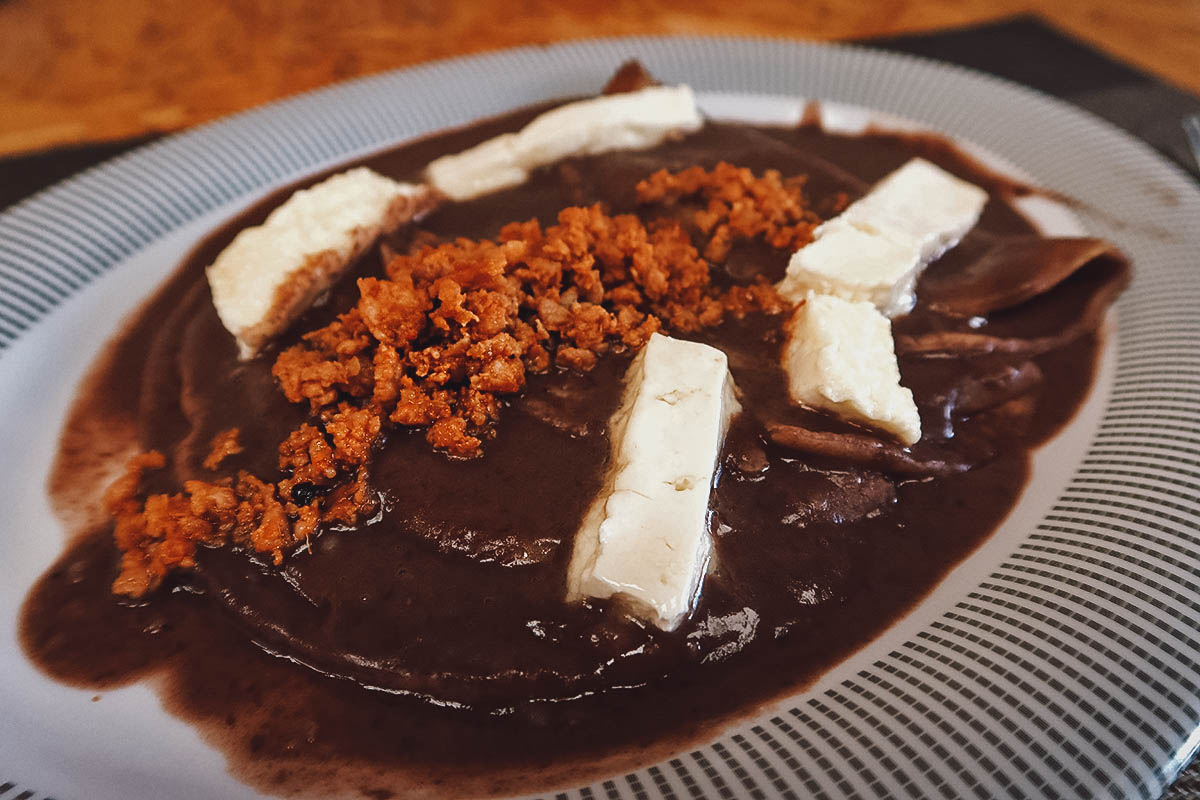
Mil Sabores is located about two blocks west of the zocalo.
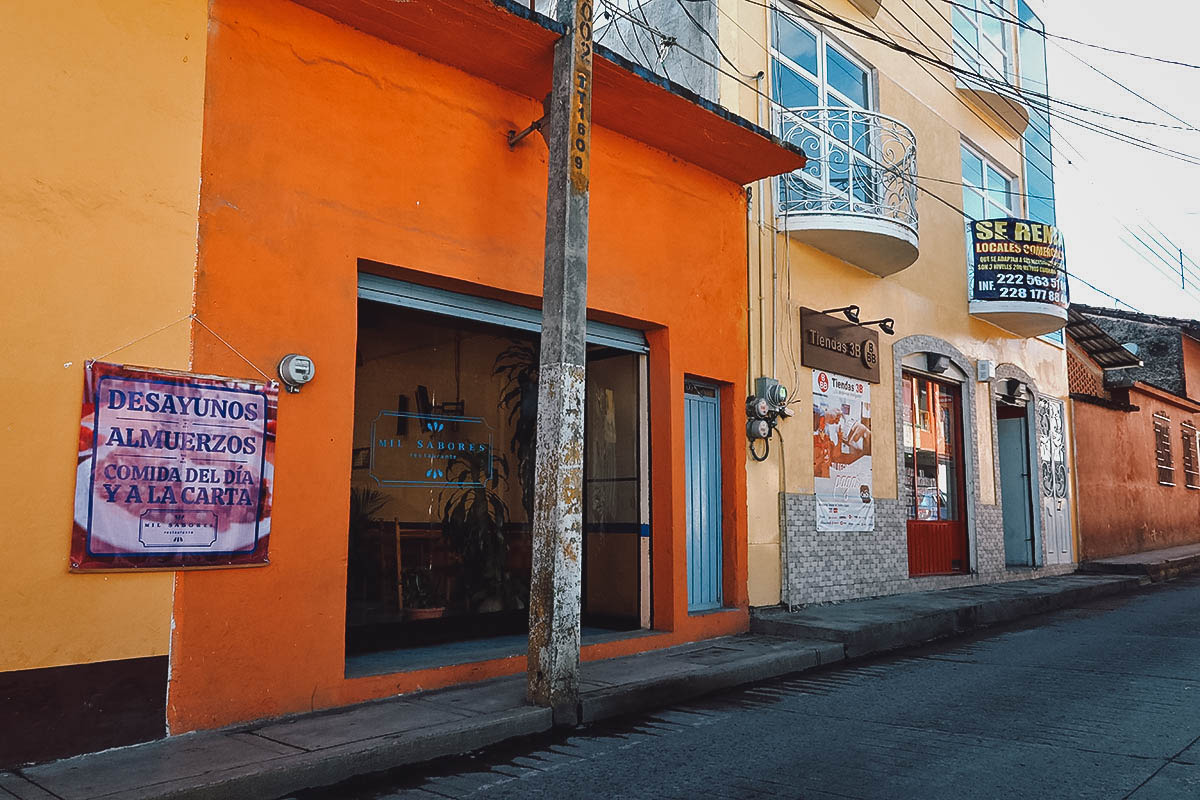
POINTS OF INTEREST IN TLATLAUQUITEPEC
To help you find these attractions, restaurants, and hotels in Tlatlauquitepec, I’ve pinned them all on this map. Click on the link for a live version of the map.
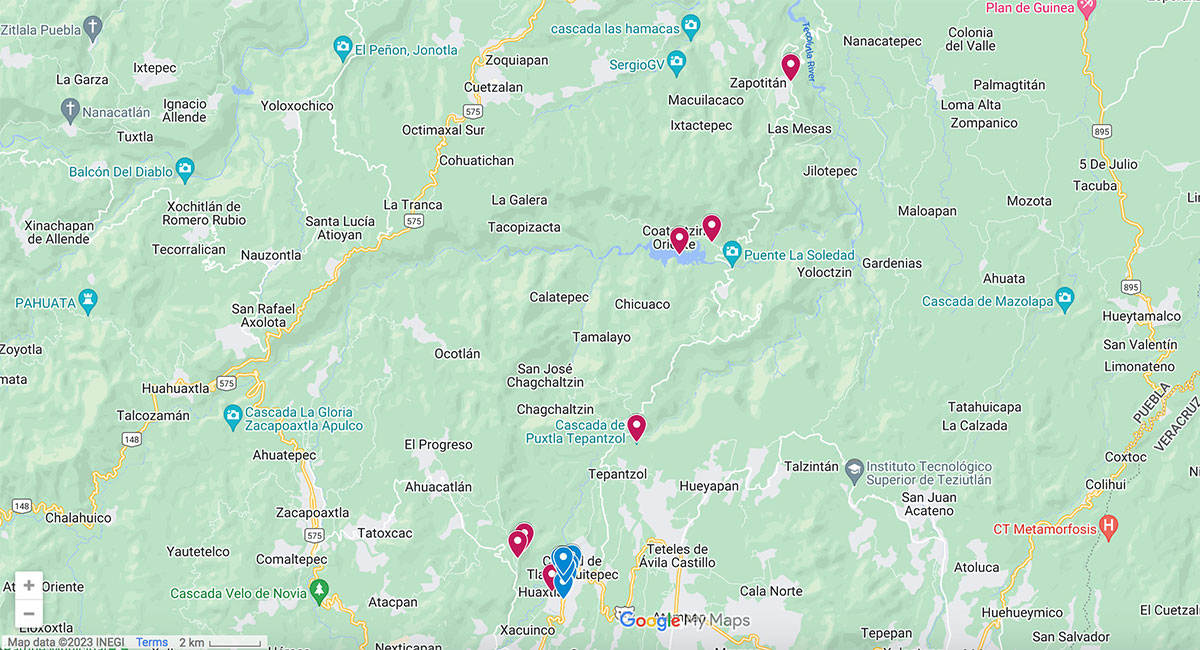
TLATLAUQUITEPEC ITINERARY
Two full days should be enough time to experience the best of Tlatlauqui. Here’s a sample 2D/2N Tlatlauquitepec itinerary to help you plan your trip.
| DAY ONE • Explore the zocalo • Parroquia de Santa Maria de la Asuncion • Santuario del Señor de Huaxtla • Cerro Cabezon |
| DAY TWO • Go caving or hiking with a guide • Go on a fireflies tour |
TLATLAUQUITEPEC TRAVEL TIPS
1. Stay Connected with a Mexico Sim Card or eSIM
It goes without saying that having a steady internet connection is a must when traveling, especially if you’re visiting a more off-the-beaten-path destination like Tlatlauqui. You’ll need to be connected at all times to navigate and do research.
In my experience, pocket wifi devices don’t work well in Mexico so you’ll need to get a SIM card for your trip. Telcel is widely regarded to be the best ISP in Mexico while airalo is a trusted eSIM provider.
You can purchase a Telcel SIM card anywhere in Mexico but you may want to get one before your trip through Amazon (affiliate link). It’ll come with 3GB of data so you’ll be connected and ready to roll as soon as your plane lands in Mexico.
If you’d like to get an eSIM instead, then you can purchase one in advance through airalo.
2. Learn Basic Spanish
You don’t need to be fluent in Spanish to have a great time in Mexico but it helps to know a few basic phrases. Here are some of the most commonly used phrases in Spanish:
Por favor: “Please”
(Muchas) gracias: “Thank you (very much)”
Buenos dias: “Good morning”
Buenas tardes: “Good afternoon”
Buenas noches: “Good evening”
Con permiso: “Excuse me” (when passing someone on the street)
Perdon/Desculpe: “Sorry” or “Excuse me” (when you didn’t hear what someone said)
¿Cuanto cuesta?: “How much does it cost?”
La cuenta por favor: “The bill please”
3. Bookmark the Puebla and Zacatlan Tripadvisor Forums
Safety can be a concern in some parts of Mexico so it’s important to always be informed. Before your trip, I suggest bookmarking and keeping an eye on the Tripadvisor travel forums. If there are any recent incidents that you need to know about, things that could potentially affect your trip, then chances are, you’ll learn about them there first.
Click on the links to go to the Puebla and Tlatlauquitepec travel forums on Tripadvisor. These forums are frequented by locals and expats so it’s a great place to ask any questions as well.
4. Start at the Tourist Information Center
Some of these less popular pueblos magicos like Tlatlauqui don’t have as much English information online. It can be hard to do adequate research which is why it’s a good idea to start your trip at the Tourist Information Center.
In my experience, the people working at these tourism offices are eager to help and can give you lots of information on tours, transportation, and other travel-related services.
Tourist information centers in Mexico are usually located around the zocalo. You can refer to our location map to find the tourist office in Tlatlauqui.
5. Go With a Guide
Hiking has its inherent dangers so if you want the safest experience, then it’s best to go with a guide. Tlatlauqui has its share of hiking trails, waterfalls, and caves – many of which are located in remote areas – so they’re best experienced on tours that provide transportation.
I had a good experience with Ruta con Magia but you should visit the Tourist Information Center for more options.
6. Bring Cash
Some of these smaller pueblos magicos don’t have as many banks or ATM machines so it’s a good idea to bring enough cash with you.
7. Wear Proper Hiking Boots
If you plan on doing any hiking or caving, then proper footwear is a must. Depending on what you plan on doing, hiking boots, aqua socks, dry bags, sunscreen, and bottled water are just a few of the essentials.
8. Don’t Drink Tap Water
It isn’t safe to drink the tap water in Mexico so you should always buy bottled water or drink from a filtered water bottle. Being stricken with Montezuma’s Revenge would suck so check out my article on the drinking water in Mexico for more information.
9. Leave a Tip
While there is a tipping culture in Mexico, it seems to apply more to larger cities that get a steady influx of foreign visitors. In some of these smaller pueblos magicos, tipping doesn’t seem to be as expected (ie no tip jars).
As a token of appreciation, I always leave a tip of around 10% of the total bill, whether it be a restaurant, street food stall, or fonda. You can read my article on tipping in Mexico for more tips.
10. Get Travel Insurance
Getting travel insurance is a must when traveling, because frankly, you never know what might happen. For peace of mind, we suggest picking up a travel insurance policy from Heymondo (non-US residents get 5% off). Click on the link to learn more and get a free quotation.
11. Bring the Right Power Adapter
Mexico has Type A or Type B electrical outlets so be sure to bring the right power adapters for your devices. Electrical voltage is 127V and the standard frequency is 60Hz.
WHAT I LOVED ABOUT TLATLAUQUITEPEC
In parting, I just wanted to share some of the things that I personally loved about Tlatlauquitepec:
|
OUR TRAVEL GEAR
Here are some of the things I brought with me to Tlatlauquitepec and Mexico. (Amazon affiliate links)
Disclosure
Some of the links in this travel guide to Tlatlauquitepec, Puebla are affiliate links. What that means is that we’ll earn a small commission if you make a purchase at no additional cost to you. As always, we only recommend products and services that we use ourselves. We really appreciate your support as it helps us keep this free Puebla travel website going. Thank you!






